 |
||
|
HOME
|
US Navy -
ships
|
US Navy - air
units
|
USMC - air
units
|
International
Navies
|
Weapon Systems
|
Special Reports |
||
|
US Navy - Amphibious Assault Ship LPH 3 USS Okinawa |
||
|
||
| 11/21 | ||
|
Type,
class: Amphibious Assault Ship, Landing Platform
Helicopter - LPH / Iwo Jima class Builder: Philadelphia Naval Shipyard, Pennsylvania, USA STATUS: Awarded: October 24, 1958 Laid down: April 1, 1960 Launched: August 19, 1961 Commissioned: April 14, 1962 Decommissioned: December 17, 1992 Fate: sunk as a target on June 6, 2002 Namesake: The Battle of Okinawa, Japan - 1945 Ships Motto: ? Technical Data: see: INFO > Iwo Jima class Amphibious Assault Ship - LPH |
||
|
Deployments: 1971 - NASA Apollo 15 recovery - Pacific Ocean May 1972 - November 1972 with 9th Marine Amphibious Brigade (MAB) and HMM-164(C) embarked - Pacific Ocean, Vietnam War January 1975 - July 1975 with 31st Marine Amphibious Unit (MAU) and HMH-462(C) embarked - Vietnam War January 1980 - July 1980 with 31st Marine Amphibious Unit (MAU) and HMM-165(C) embarked - Pacific Ocean, Indian Ocean August 1985 - December 1985 with 13th Marine Amphibious Unit (MAU) and HMM-164(C) embarked - Pacific Ocean October 1987 - April 1988 - Persian Gulf June 1990 - April 1991 with 13th Marine Expeditionary Unit - SOC (MEU/SOC) and HMM-164(REIN) embarked - Pacific Ocean, Persian Gulf January 1992 - July 1992 with 13th Marine Expeditionary Unit - SOC (MEU/SOC) and HMM-166(REIN) embarked - Pacific + Indian Ocean, Persian Gulf |
||
| images | ||
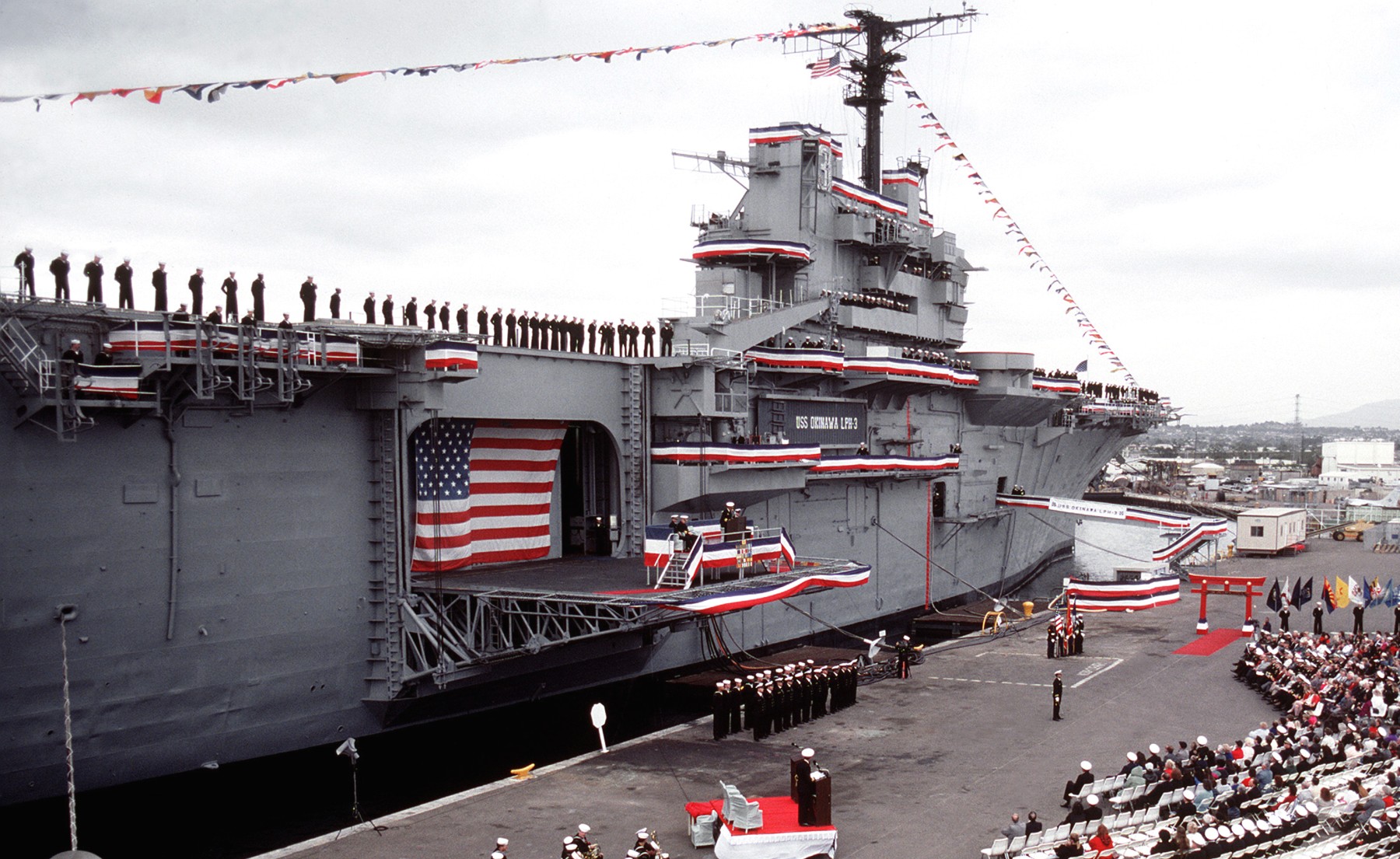 decommissioning ceremony - San Diego, California - December 17, 1992 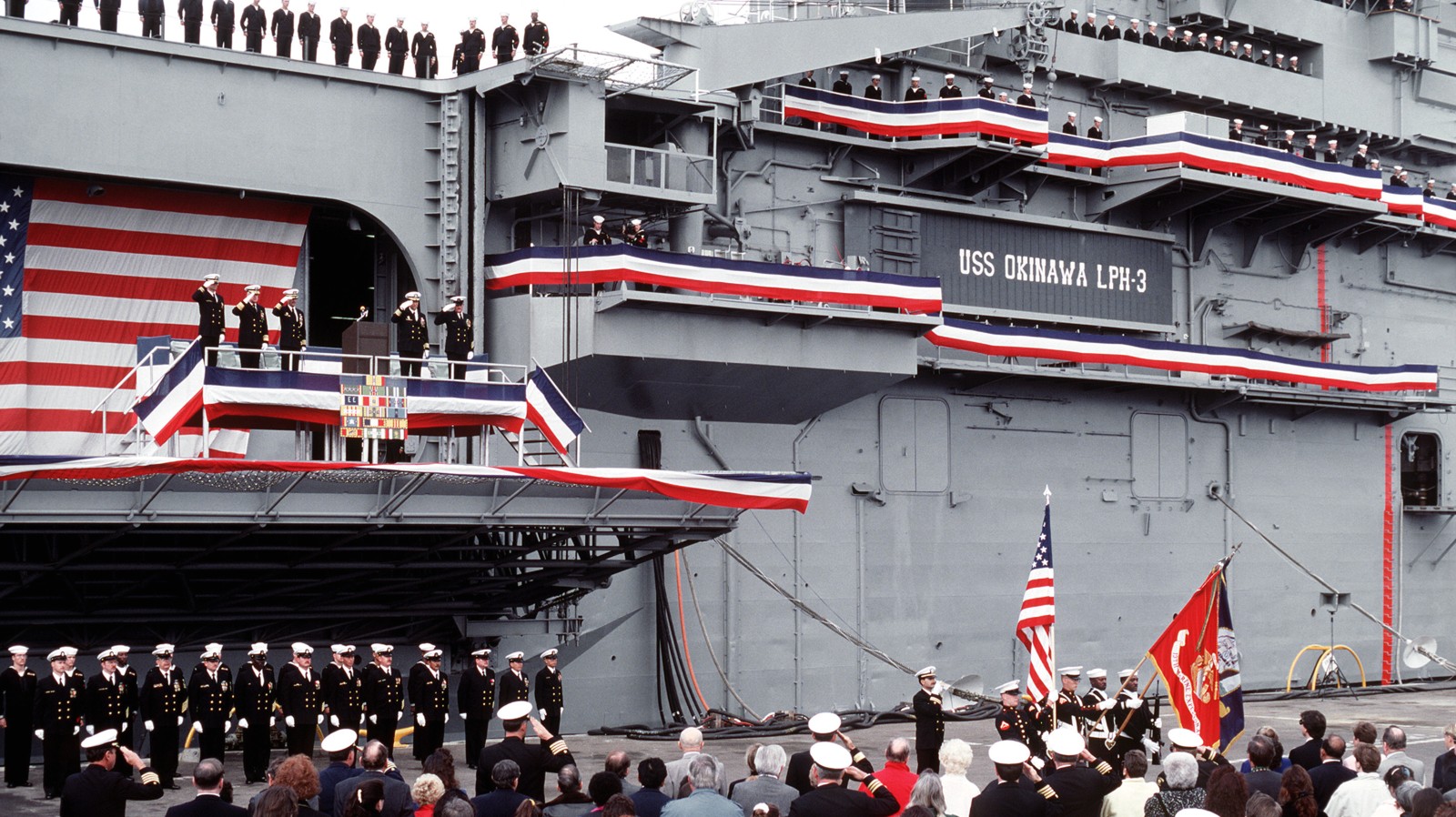 decommissioning ceremony - San Diego, California - December 17, 1992 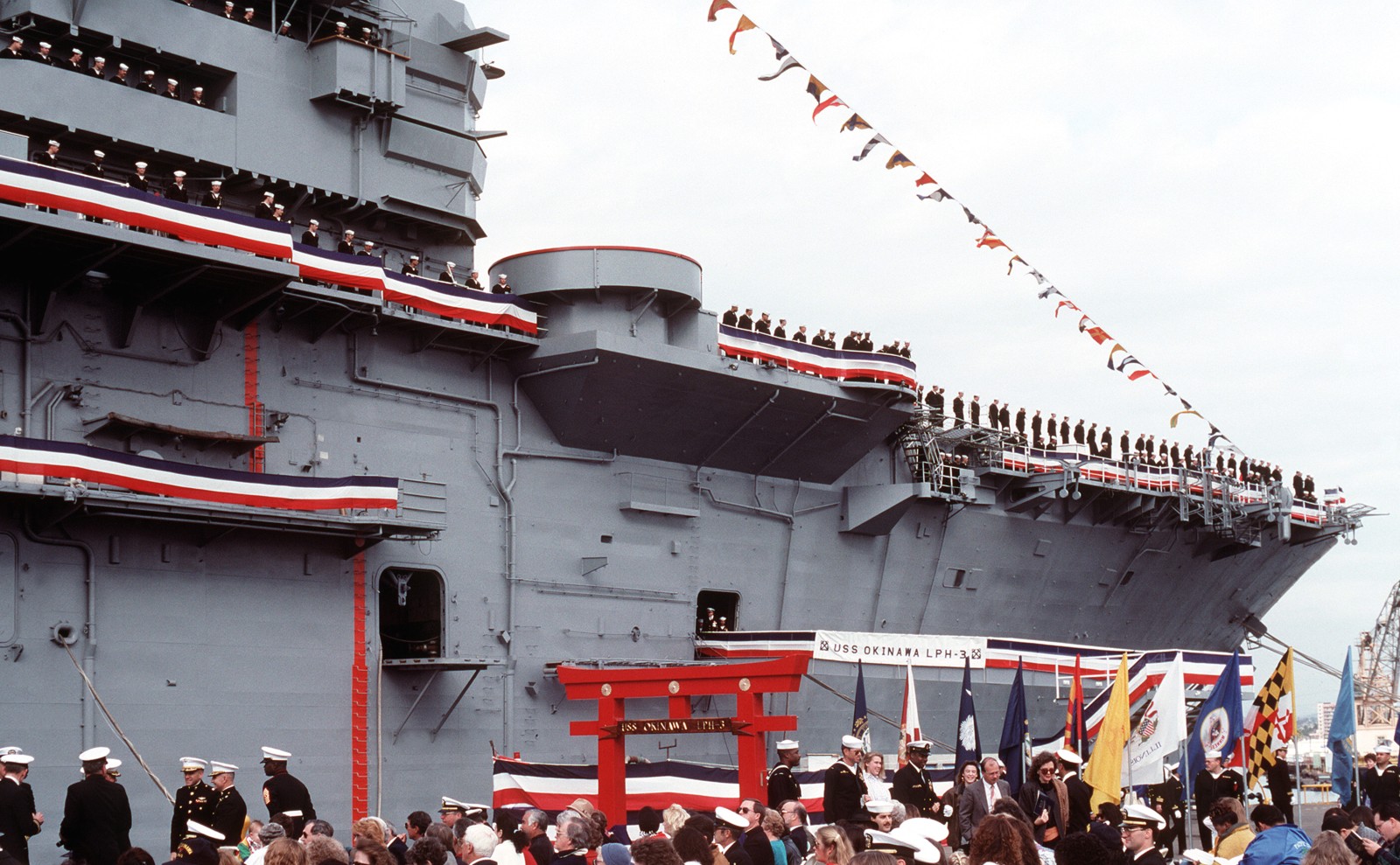 decommissioning ceremony - San Diego, California - December 17, 1992 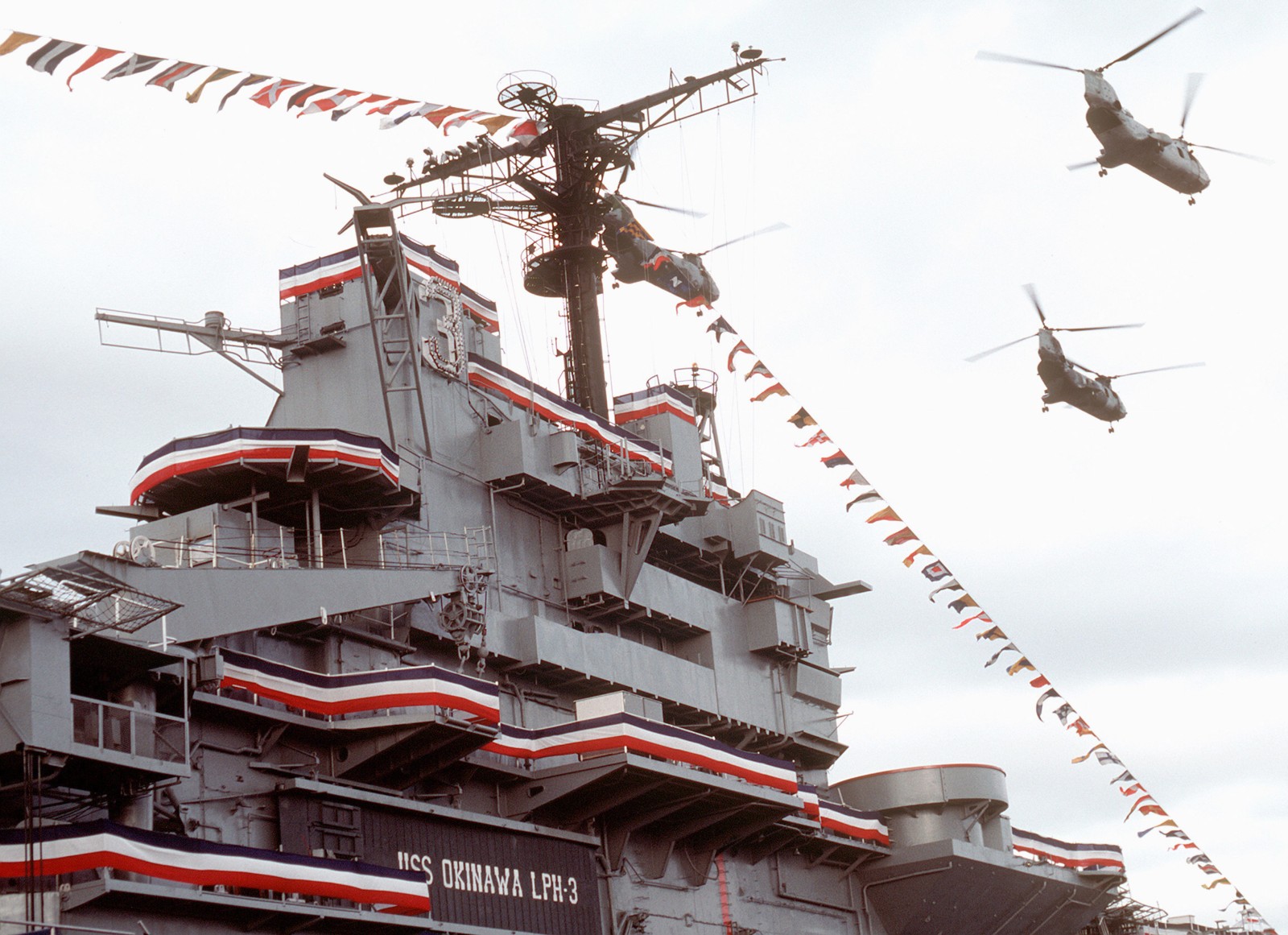 decommissioning ceremony - San Diego, California - December 17, 1992 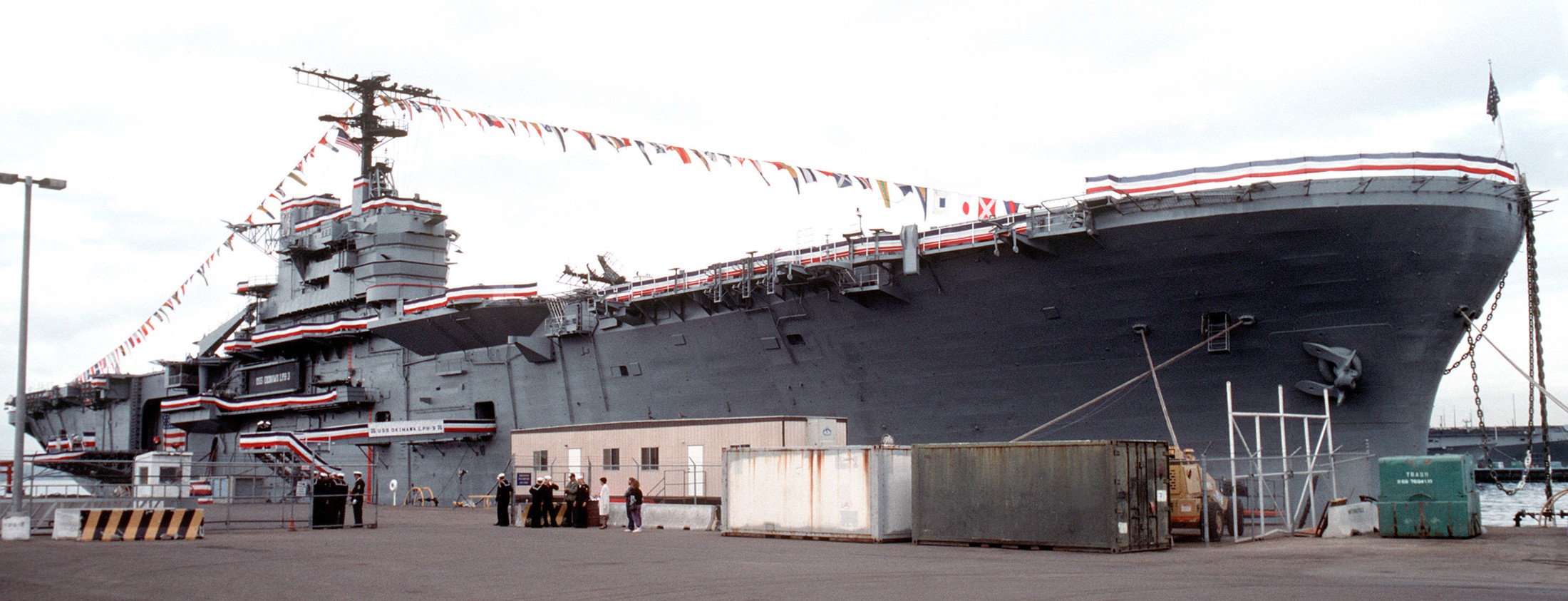 prepared for decommissioning - San Diego, California - December 17, 1992 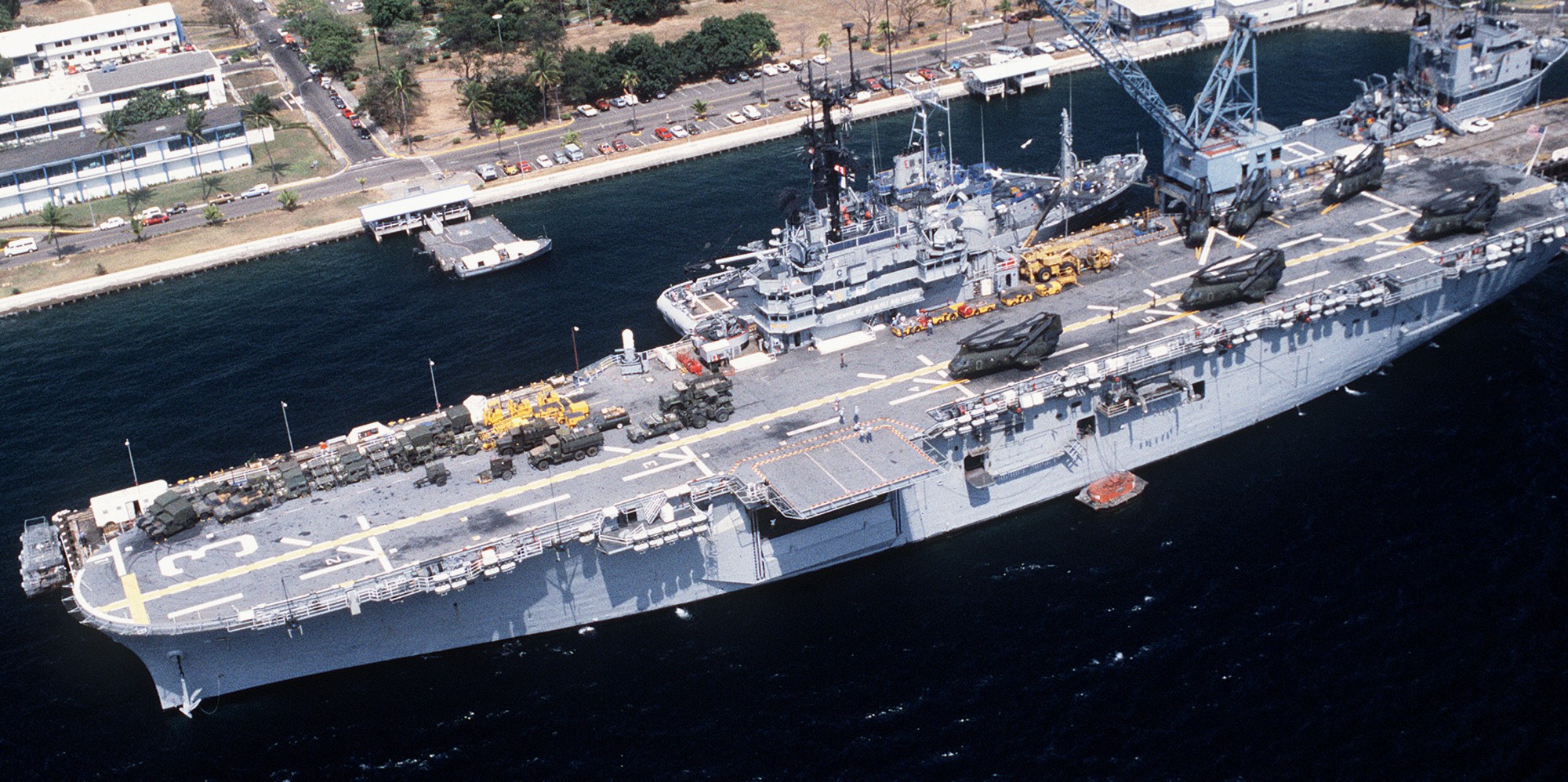 Subic Bay, Philippines - undated 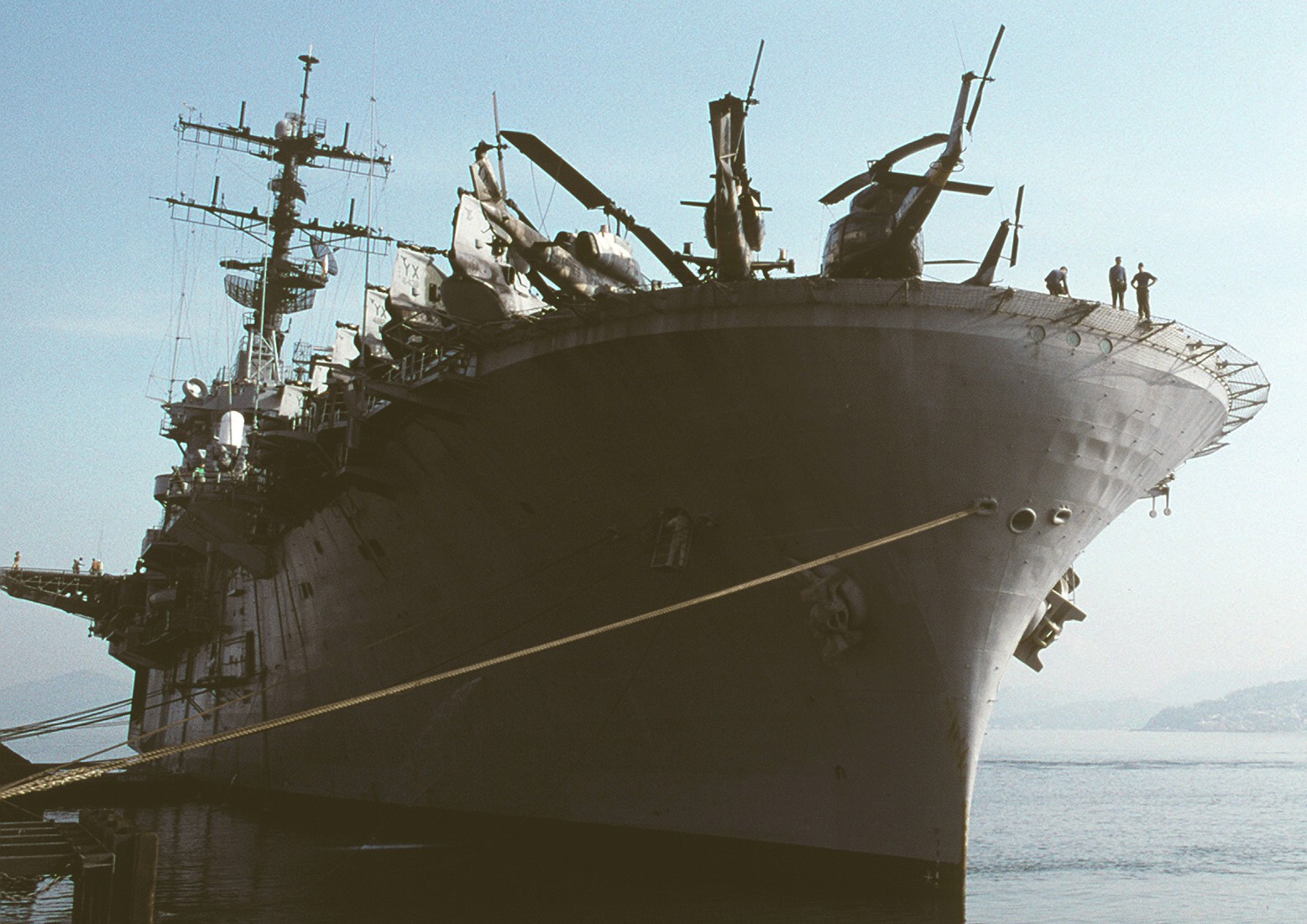 with HMM-166 embarked - Subic Bay, Philippines - June 1992 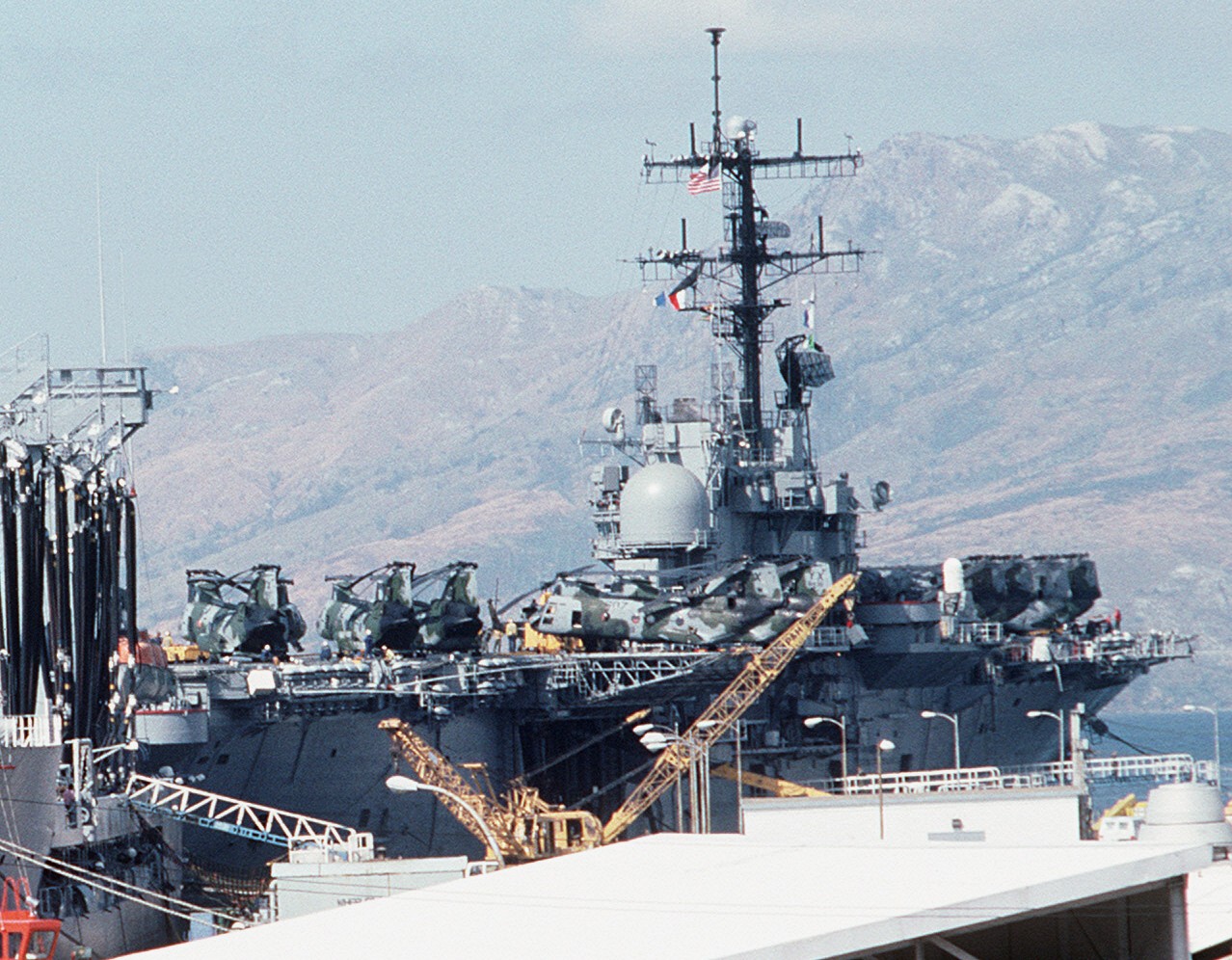 with HMM-166 embarked - Subic Bay, Philippines - February 1992 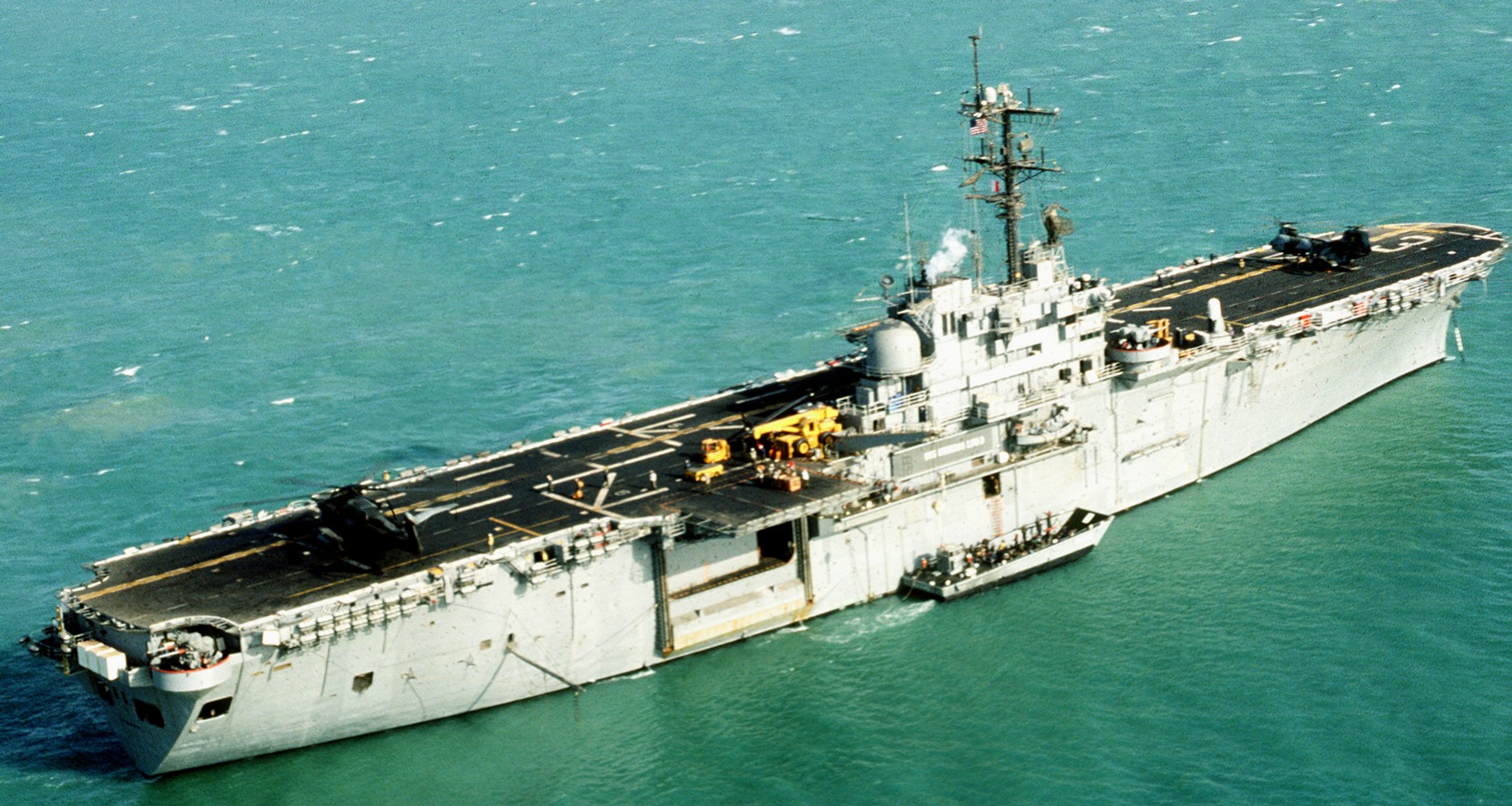 Persian Gulf - 1992 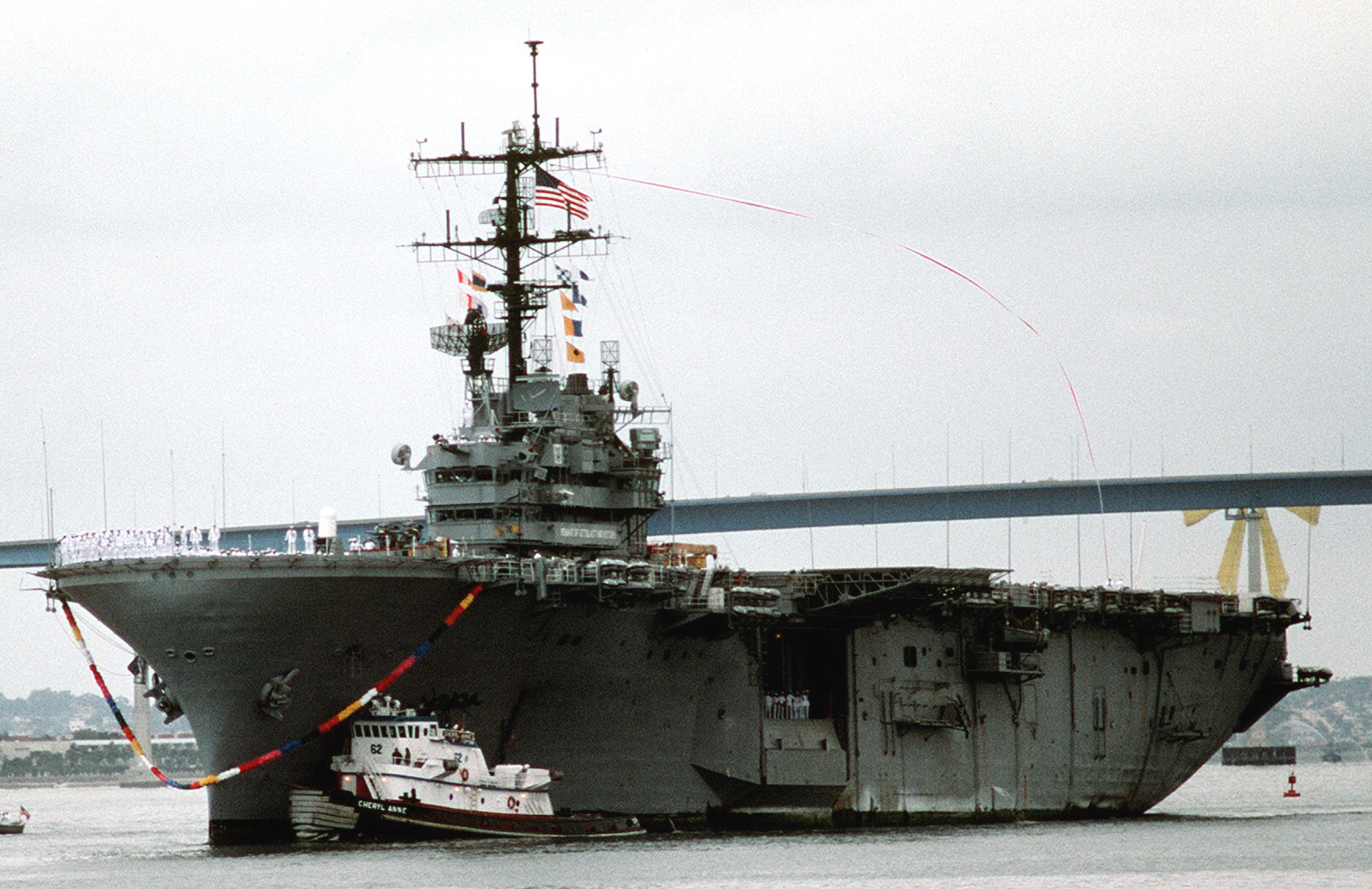 returning to San Diego - April 1991 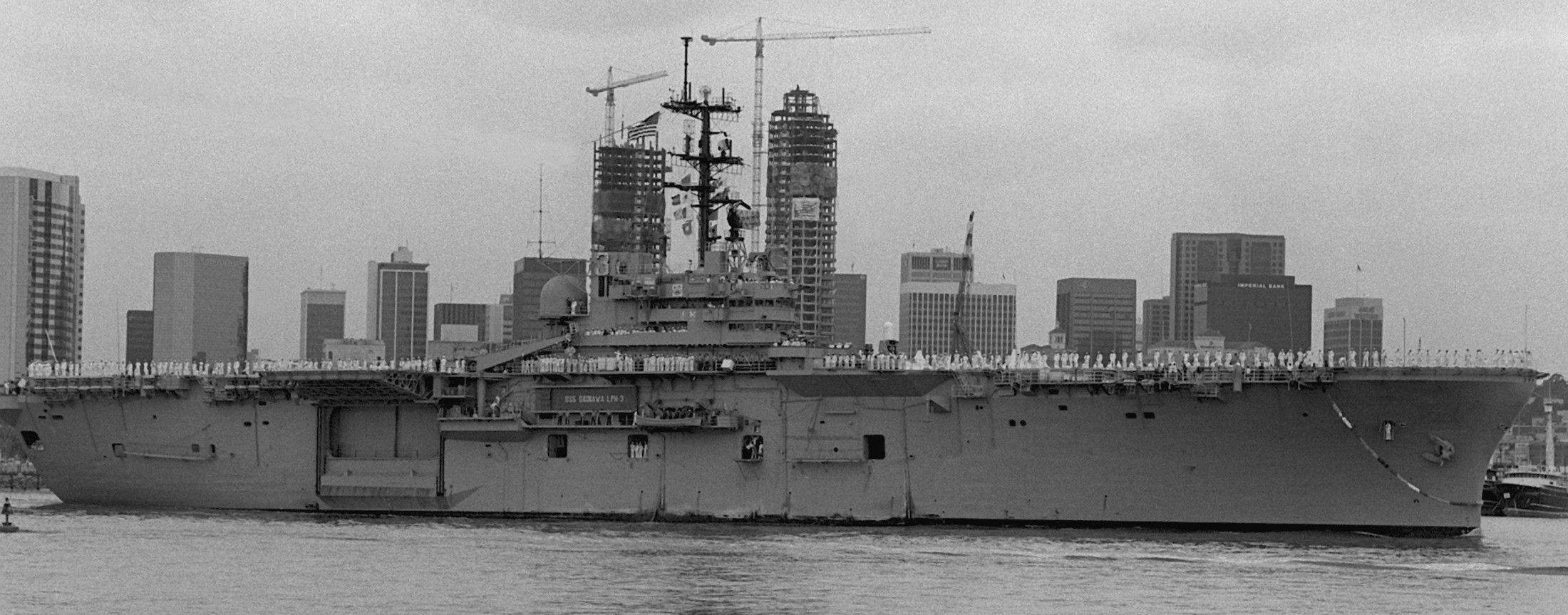 returning to San Diego - April 1991 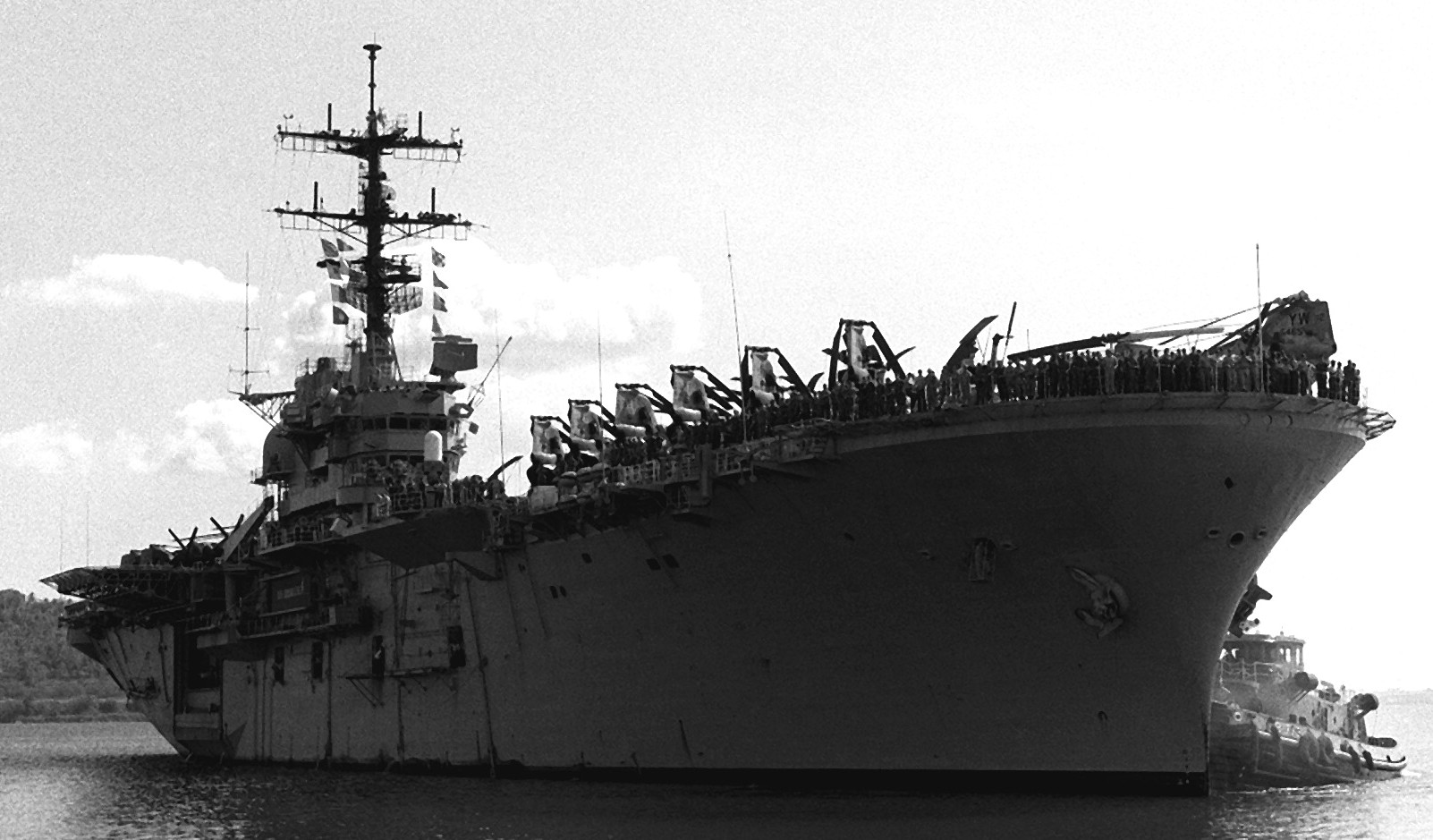 with HMM-165 embarked - Naval Station Subic Bay, Philippines - March 1991 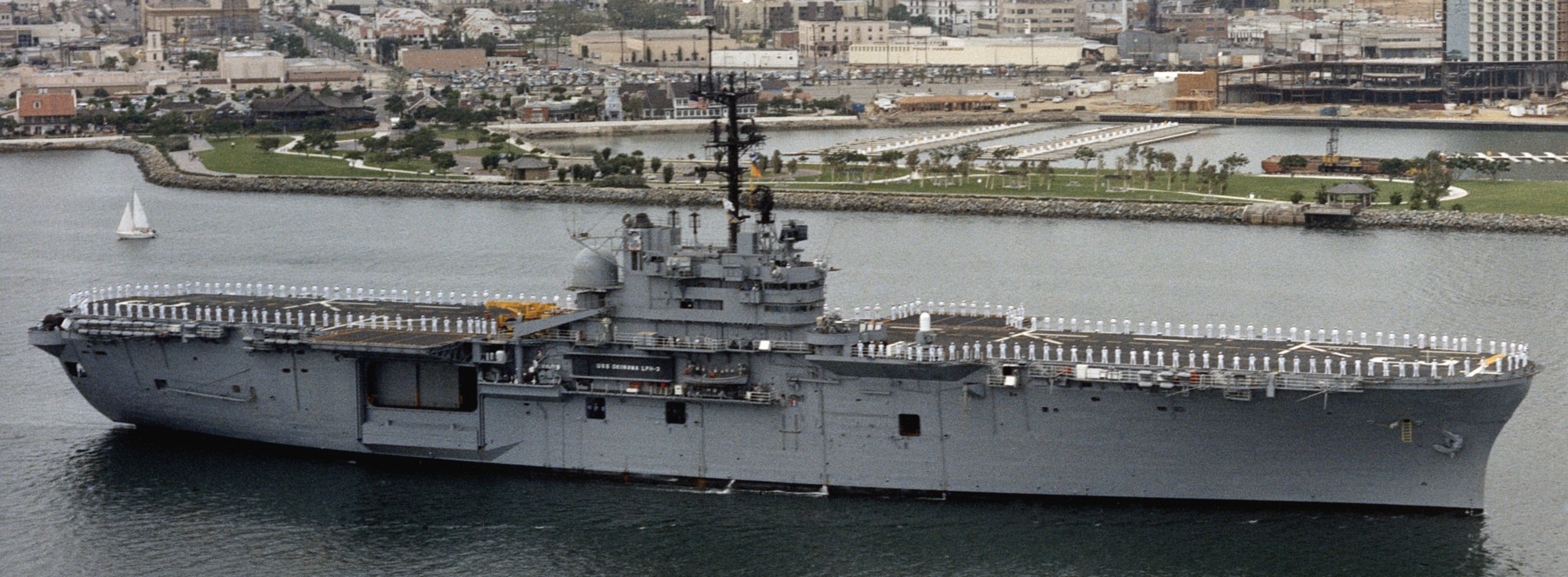 returning to San Diego, California - May 1990 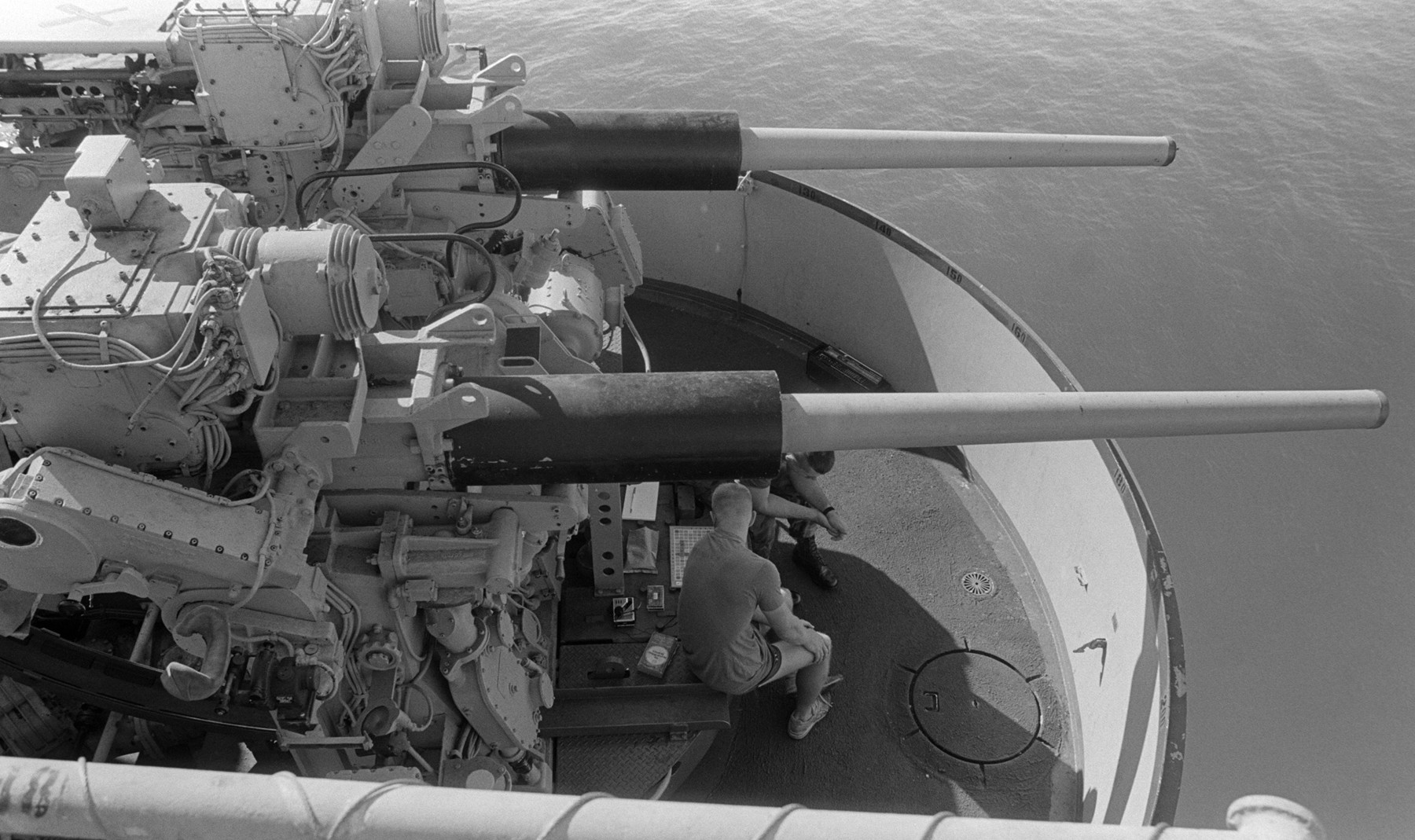 Mk.33 3”/50-caliber twin DP gun - December 1987 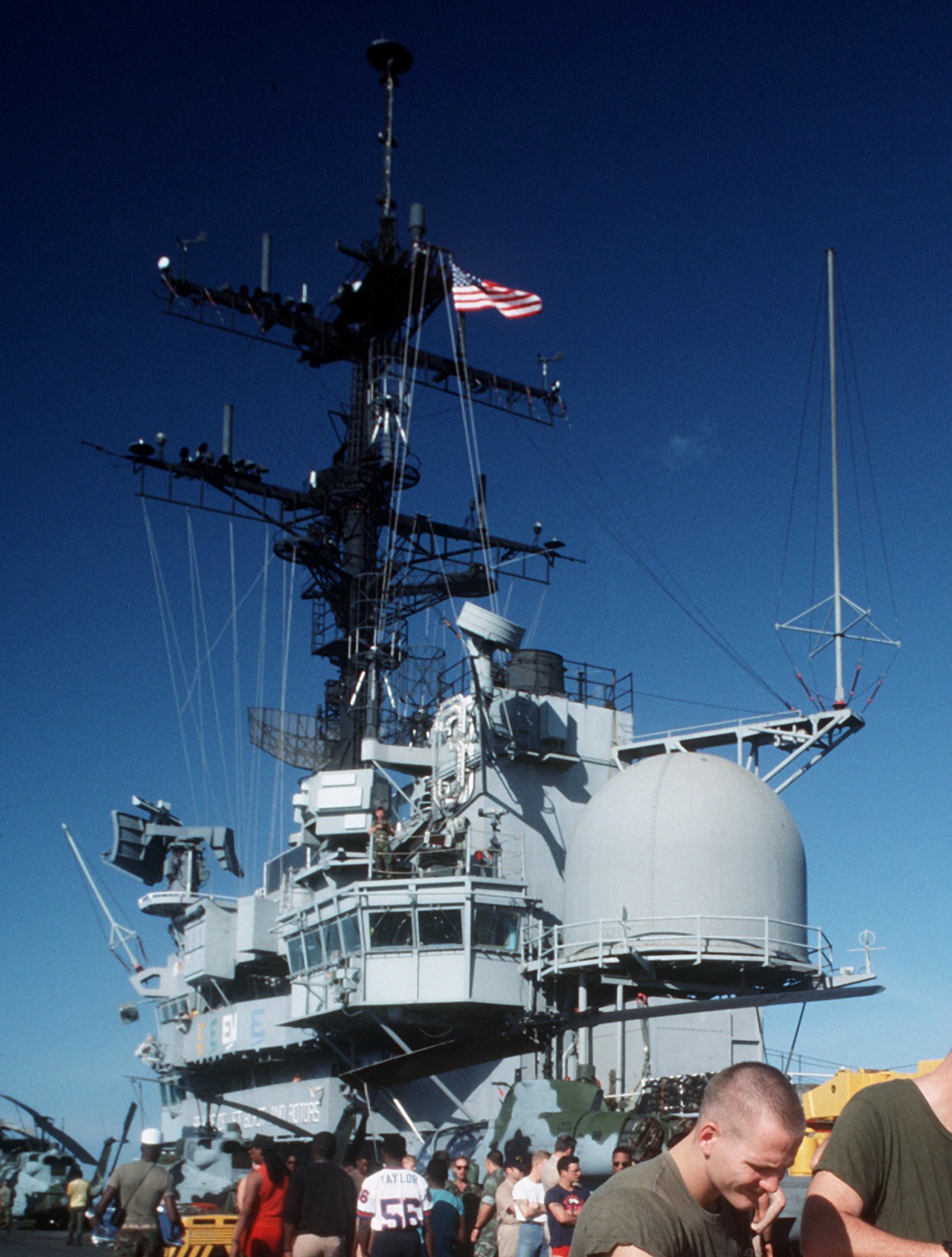 Persian Gulf - November 1987 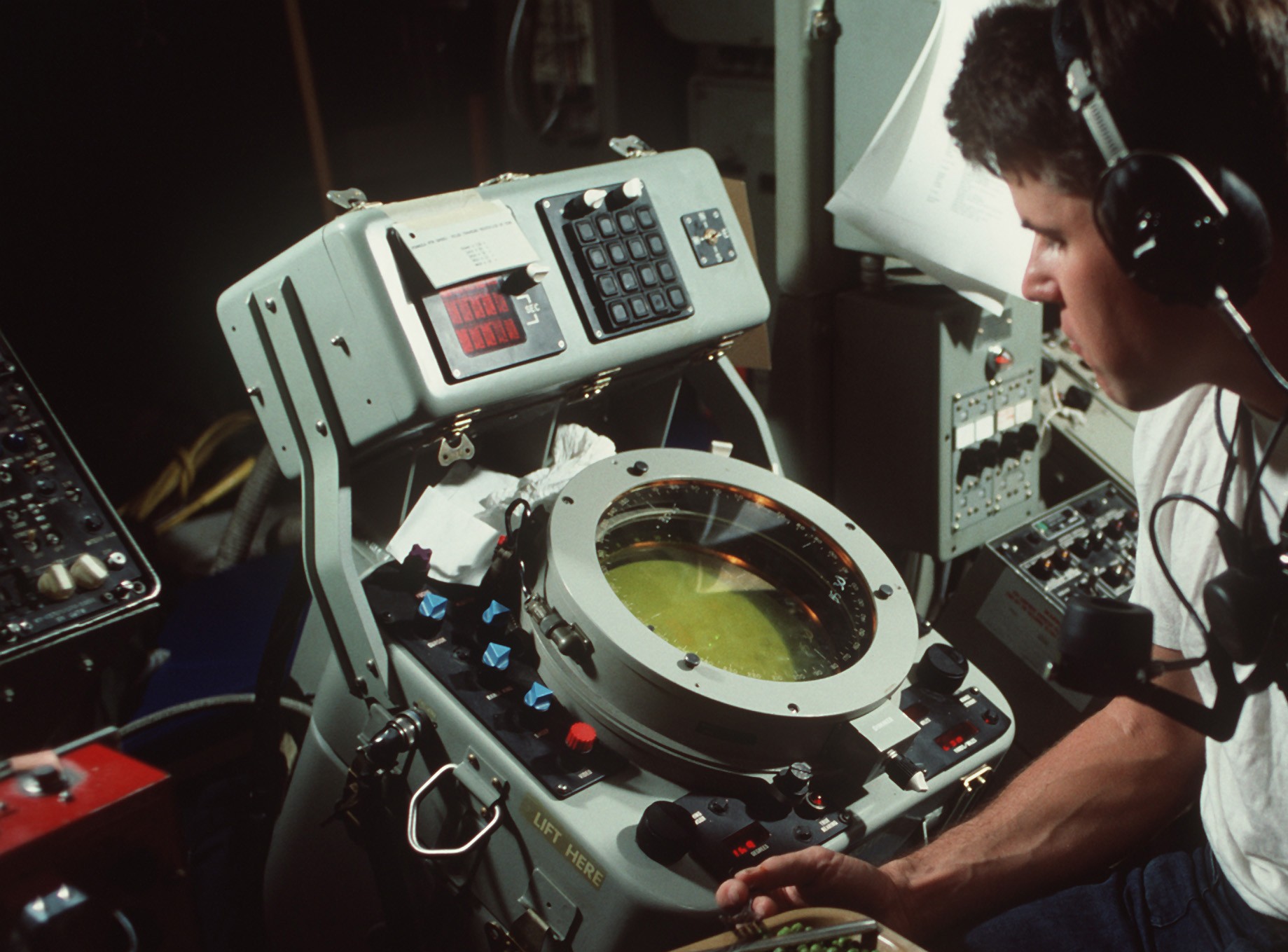 Persian Gulf - November 1987 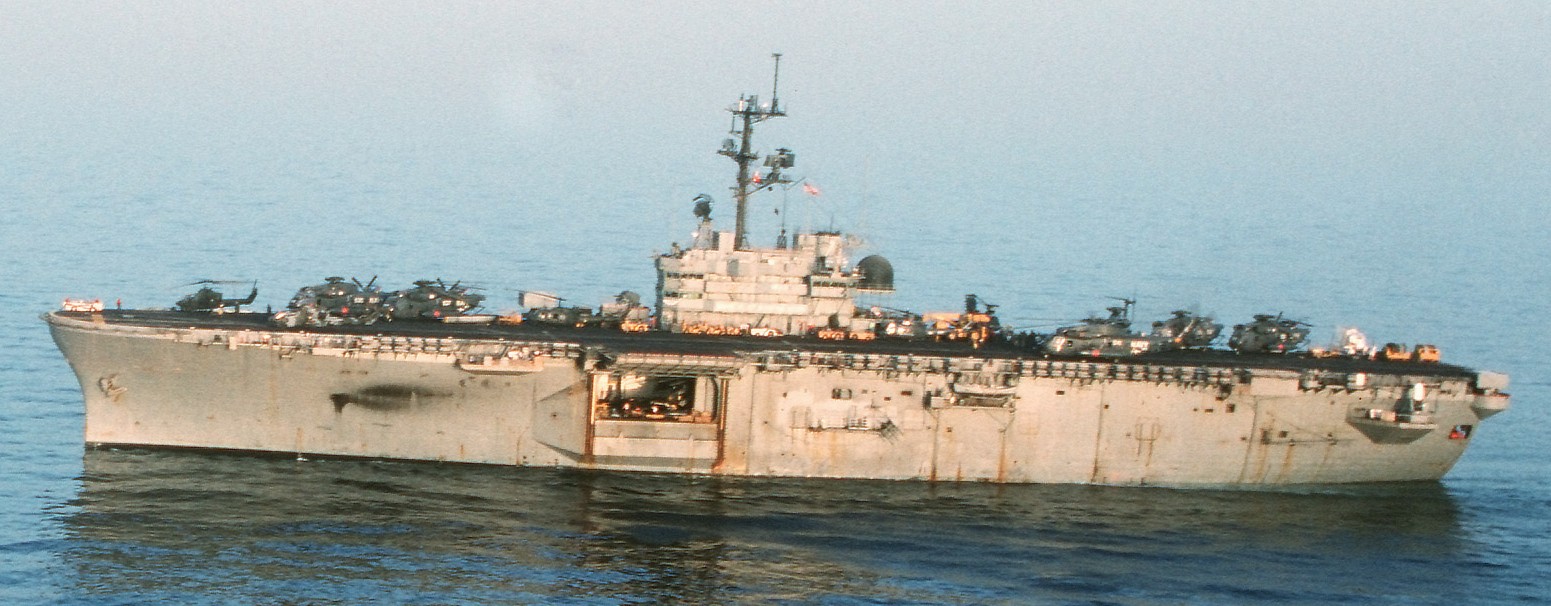 with RH-53D Sea Stallions of HM-14 embarked - Persian Gulf - 1987 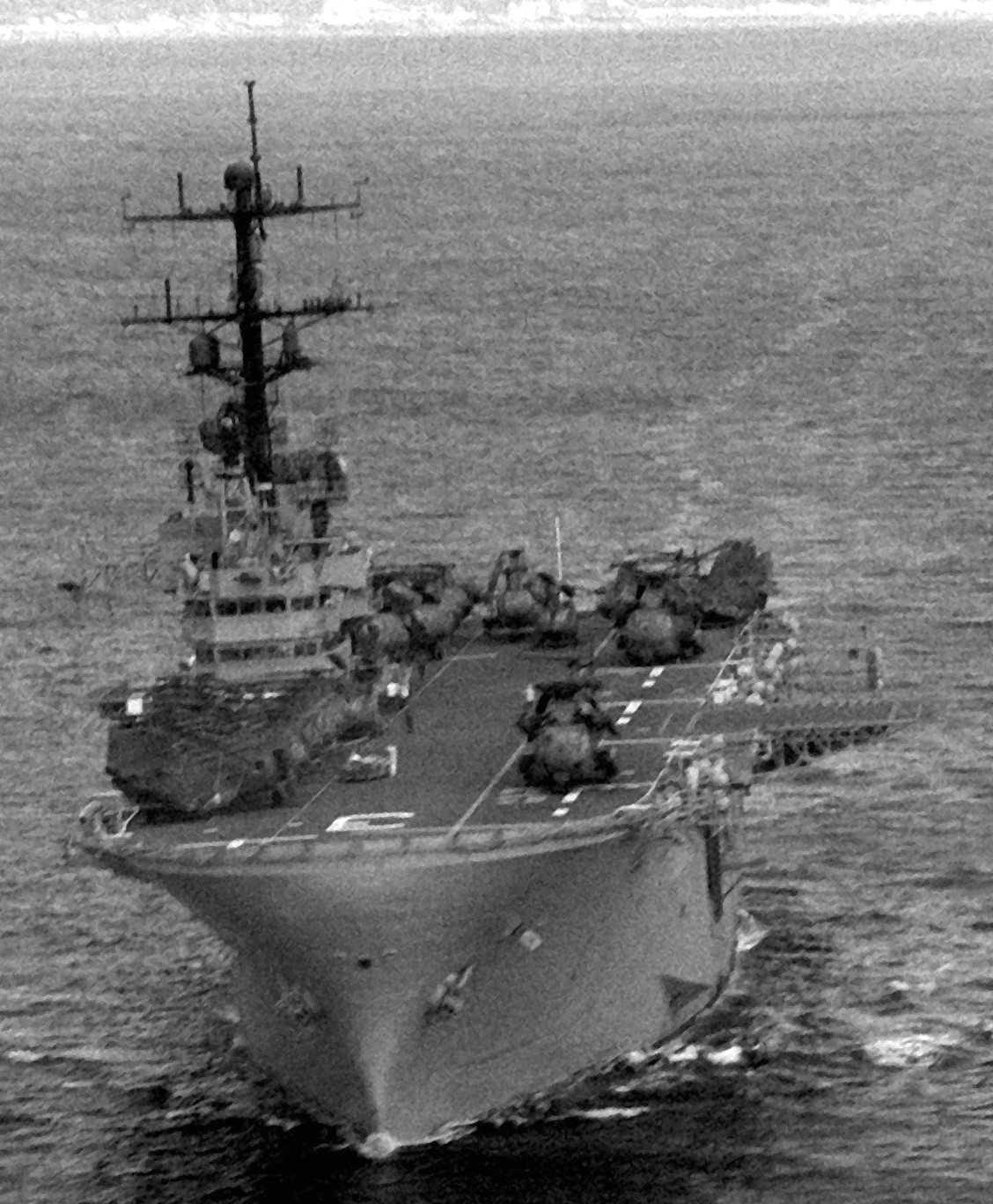 off Philippines - August 1982 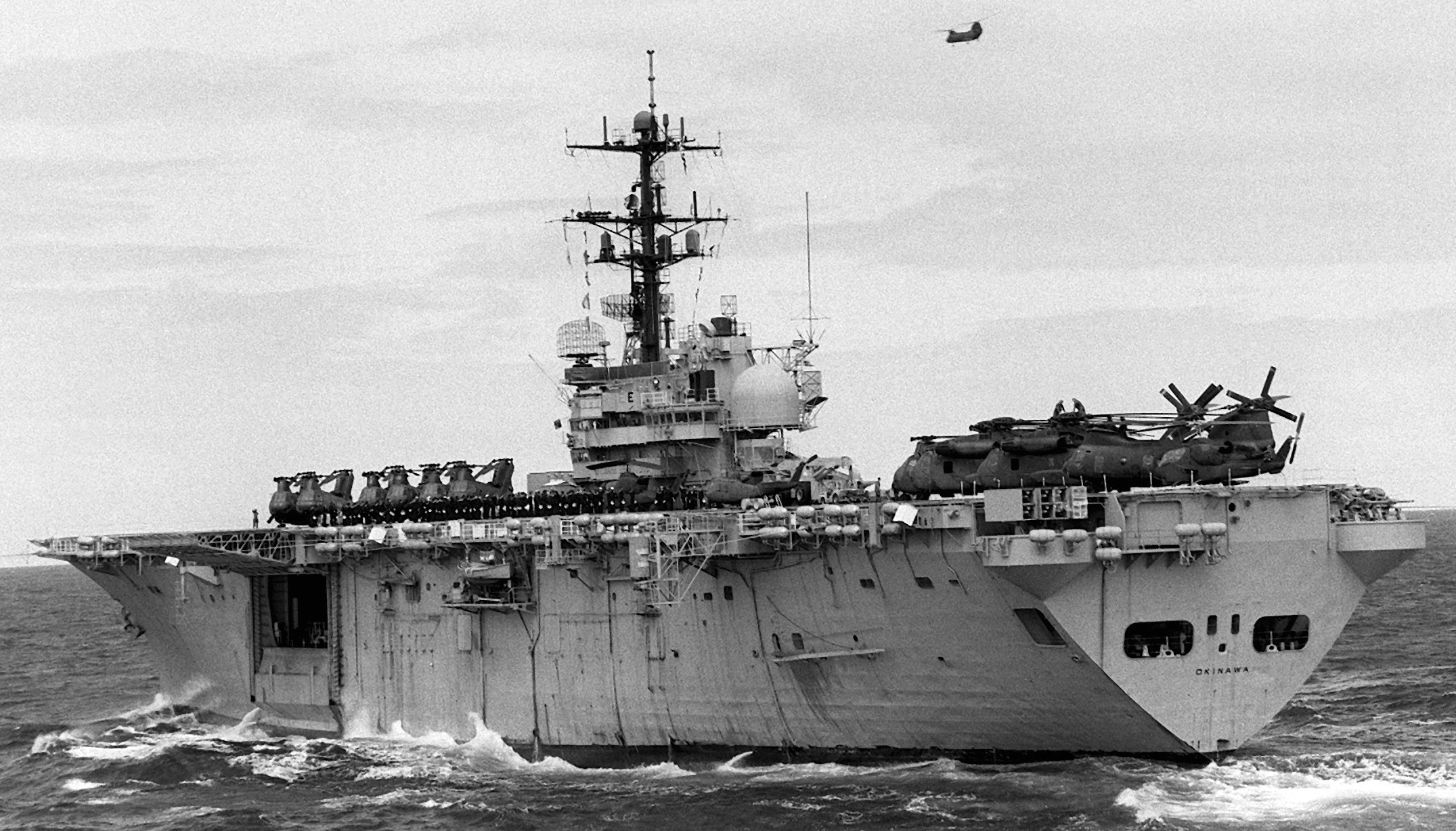 Indian Ocean - October 1981 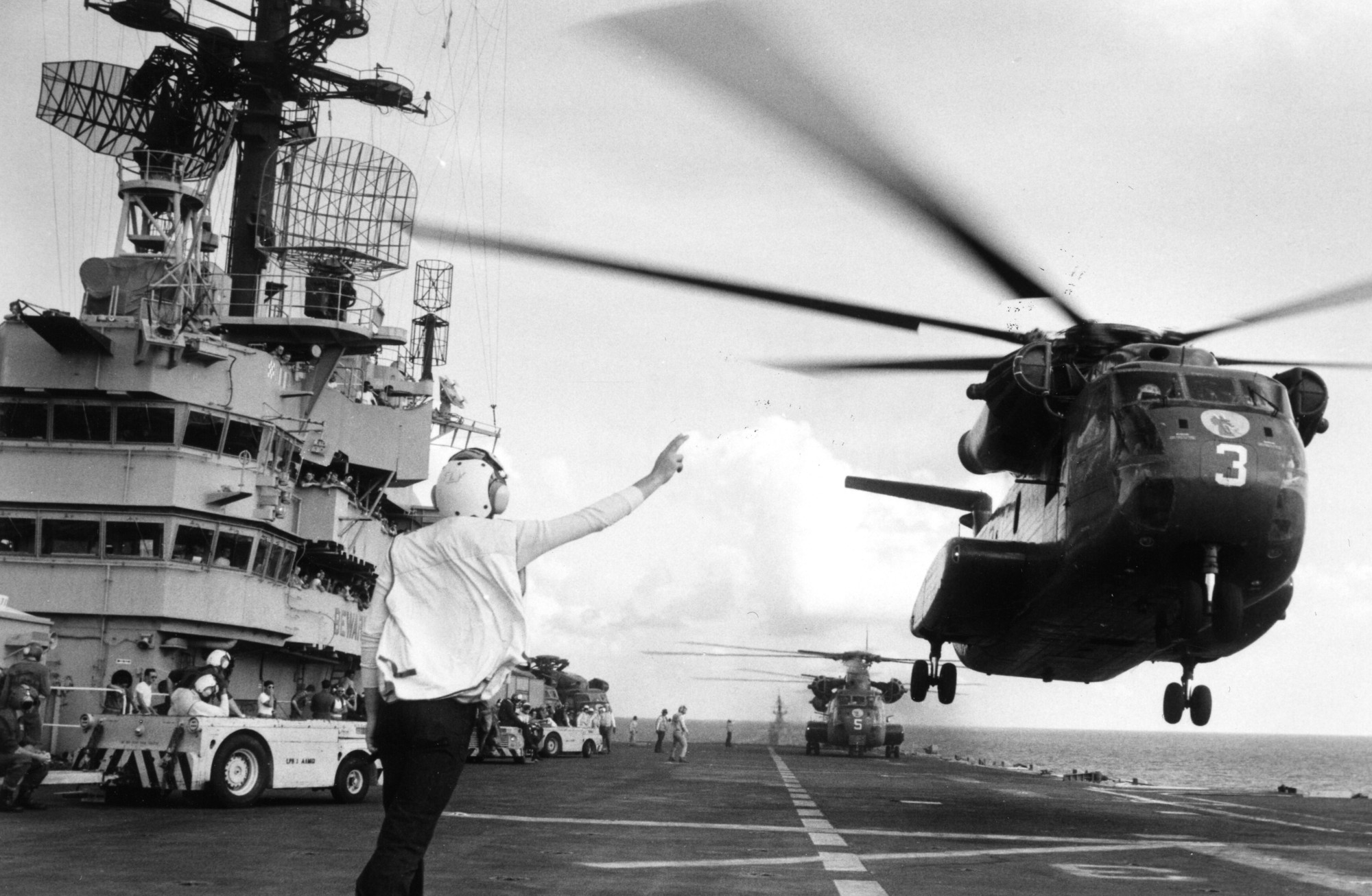 with HMH-462(C) embarked - during Operation Eagle Pull - off Cambodia - April 1975 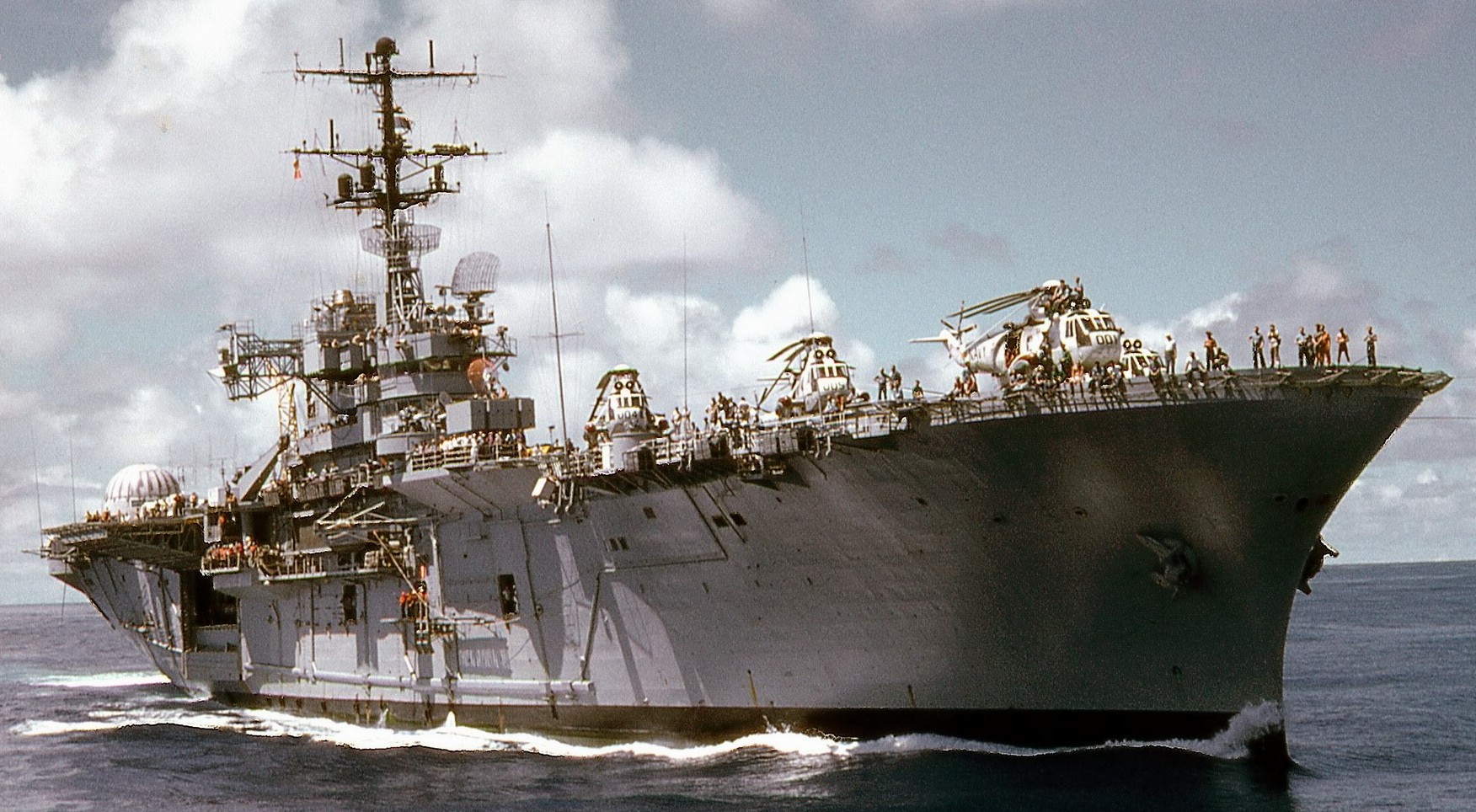 NASA Apollo 15 capsule recovery - August 7, 1971 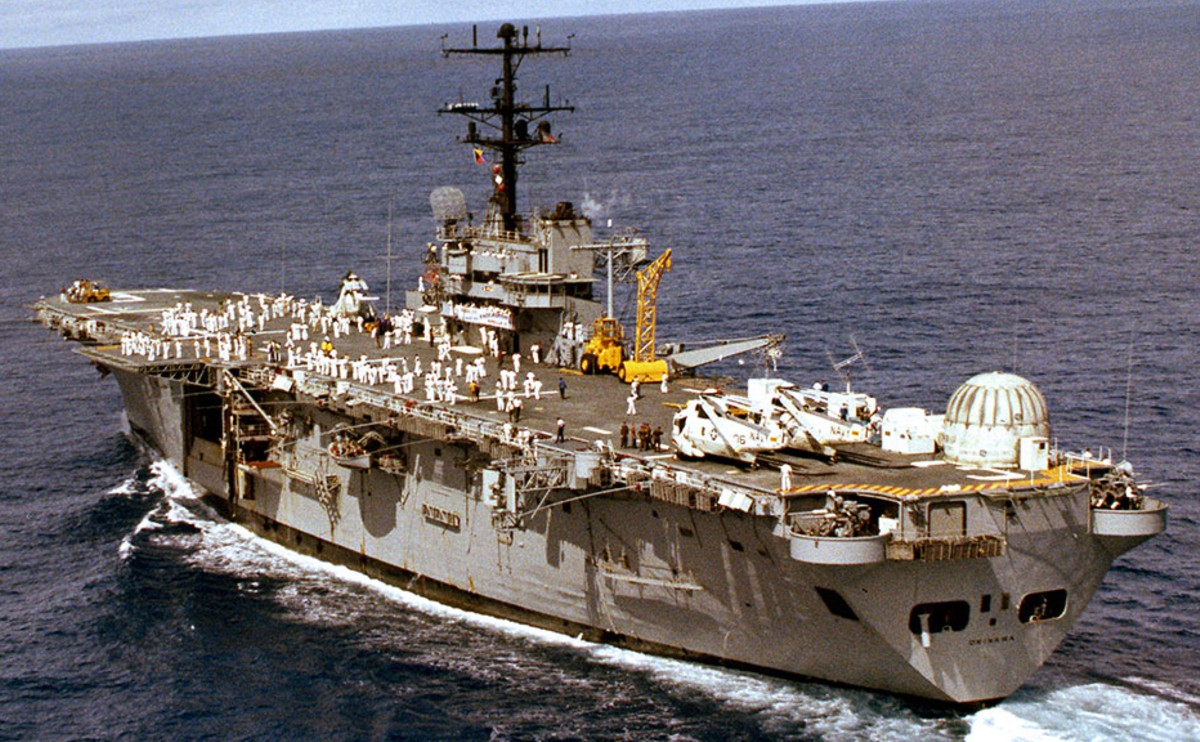 NASA Apollo 15 capsule recovery - August 7, 1971 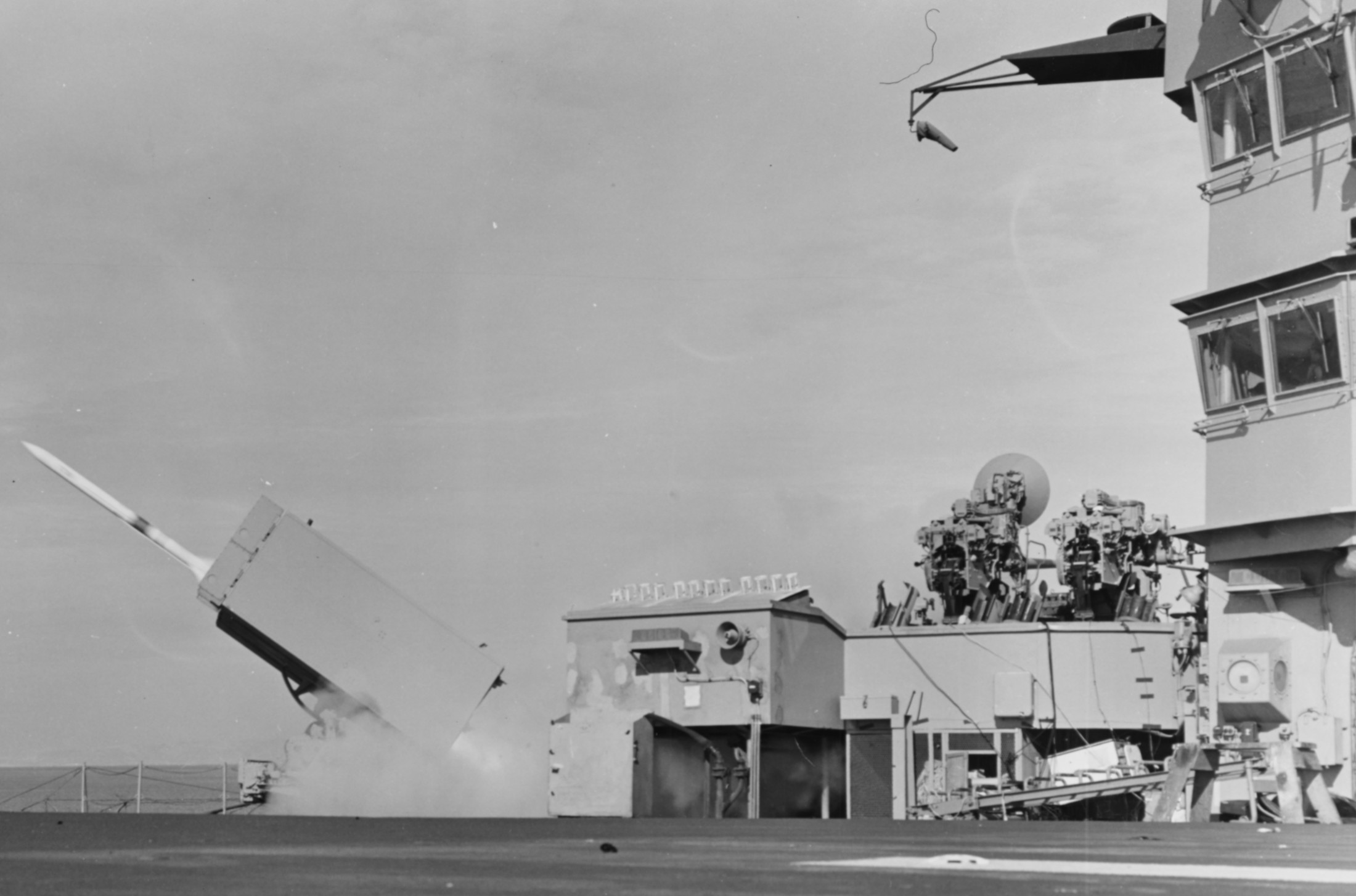 a RIM-7 Sea Sparrow SAM missile was fired from the Mk.25 Basic Point Defense Missile System (BPDMS) - January 1970 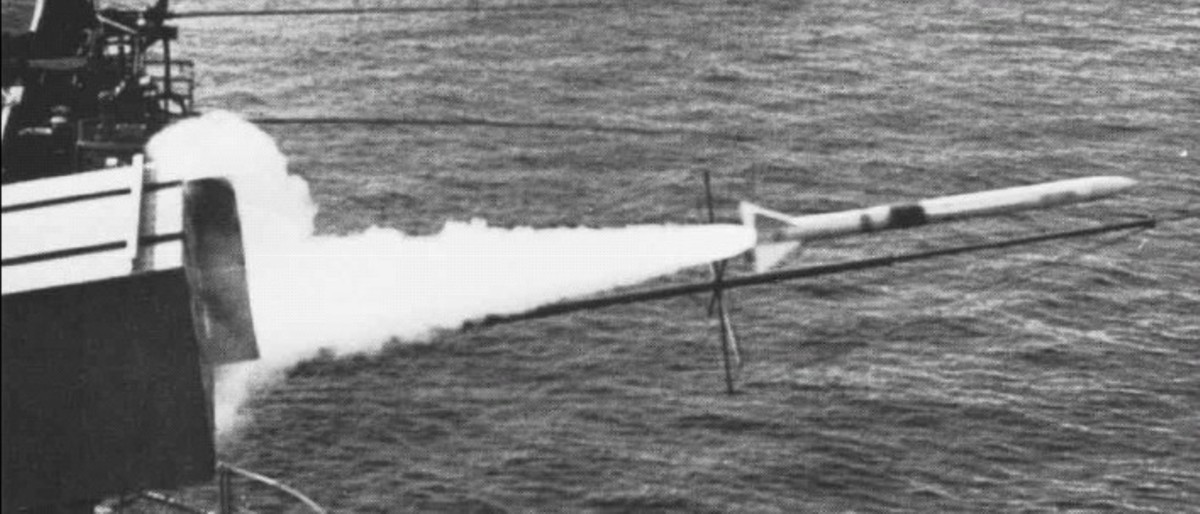 a RIM-7 Sea Sparrow SAM missile was fired from the Mk.25 Basic Point Defense Missile System (BPDMS) - January 1970 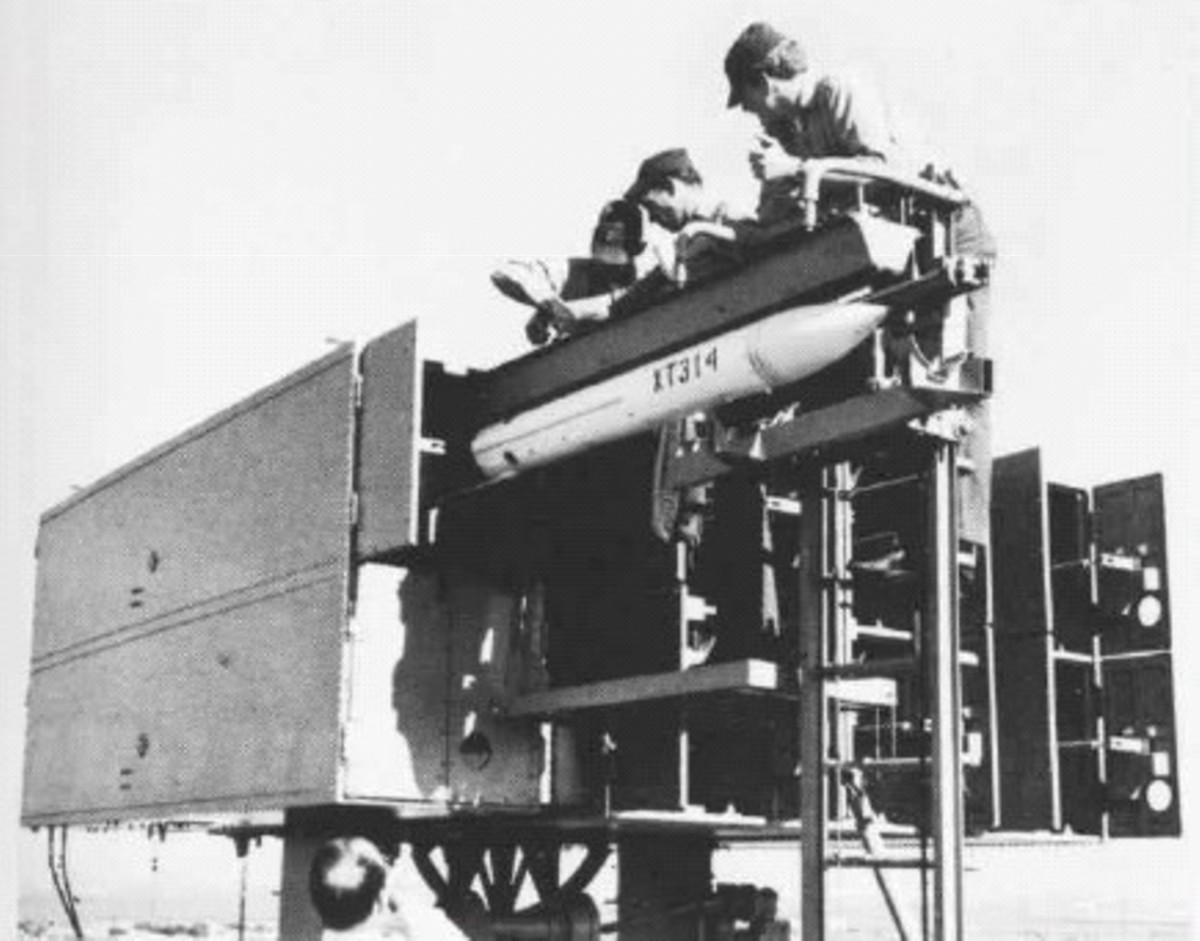 a RIM-7 Sea Sparrow SAM missile was loaded into the Mk.25 Basic Point Defense Missile System (BPDMS) - January 1970 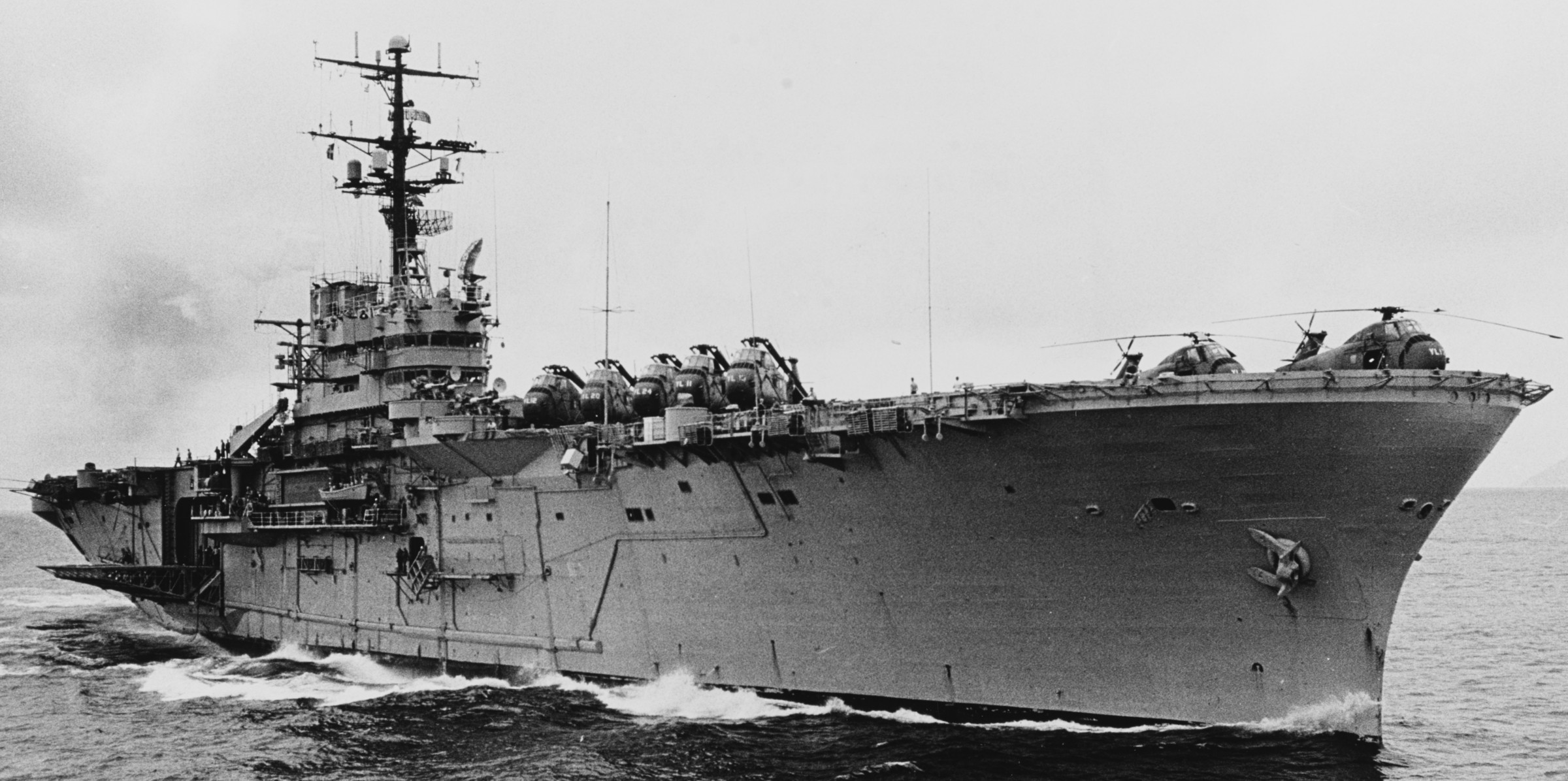 with HMM-362 embarked - South China Sea - January 1969 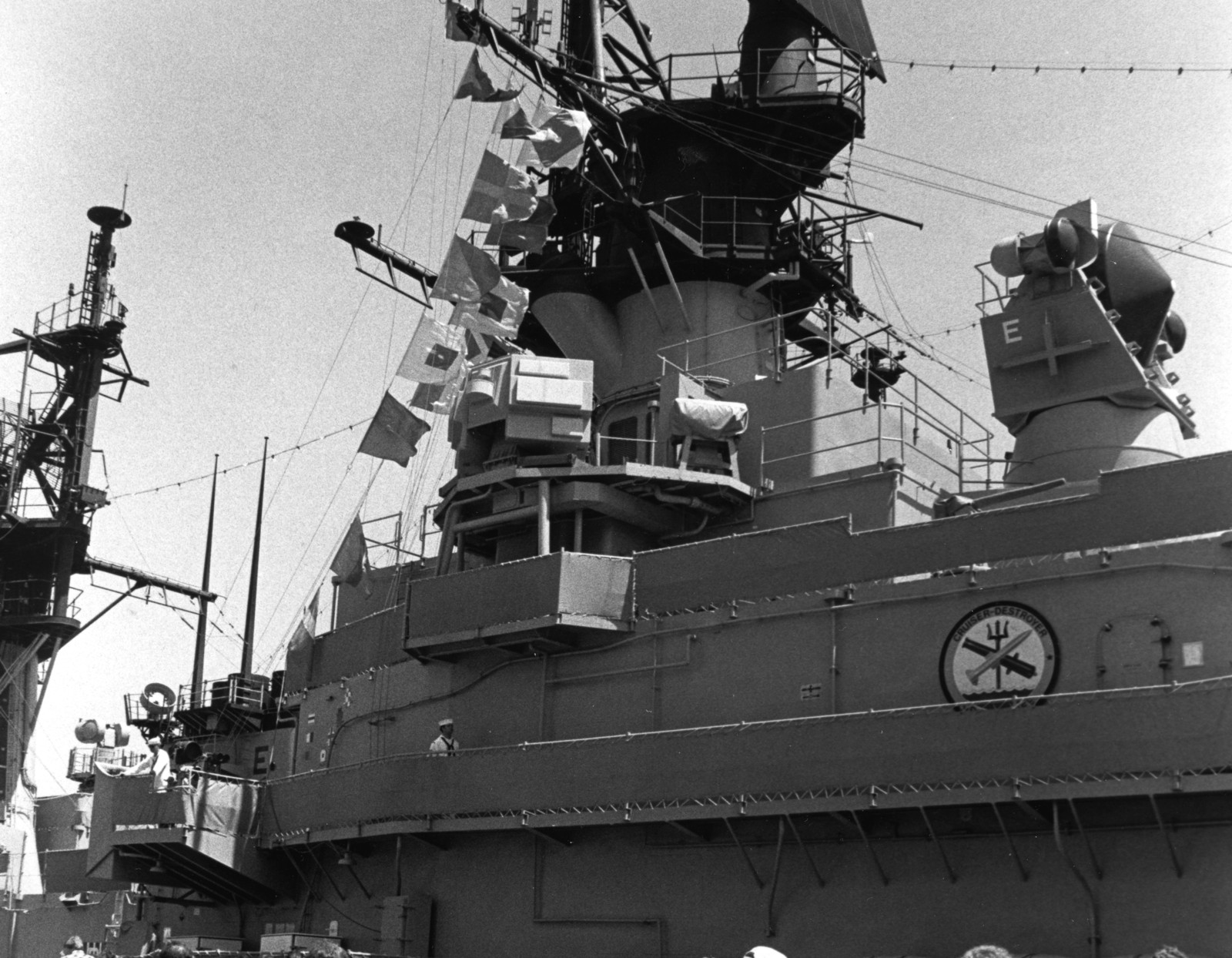 undated 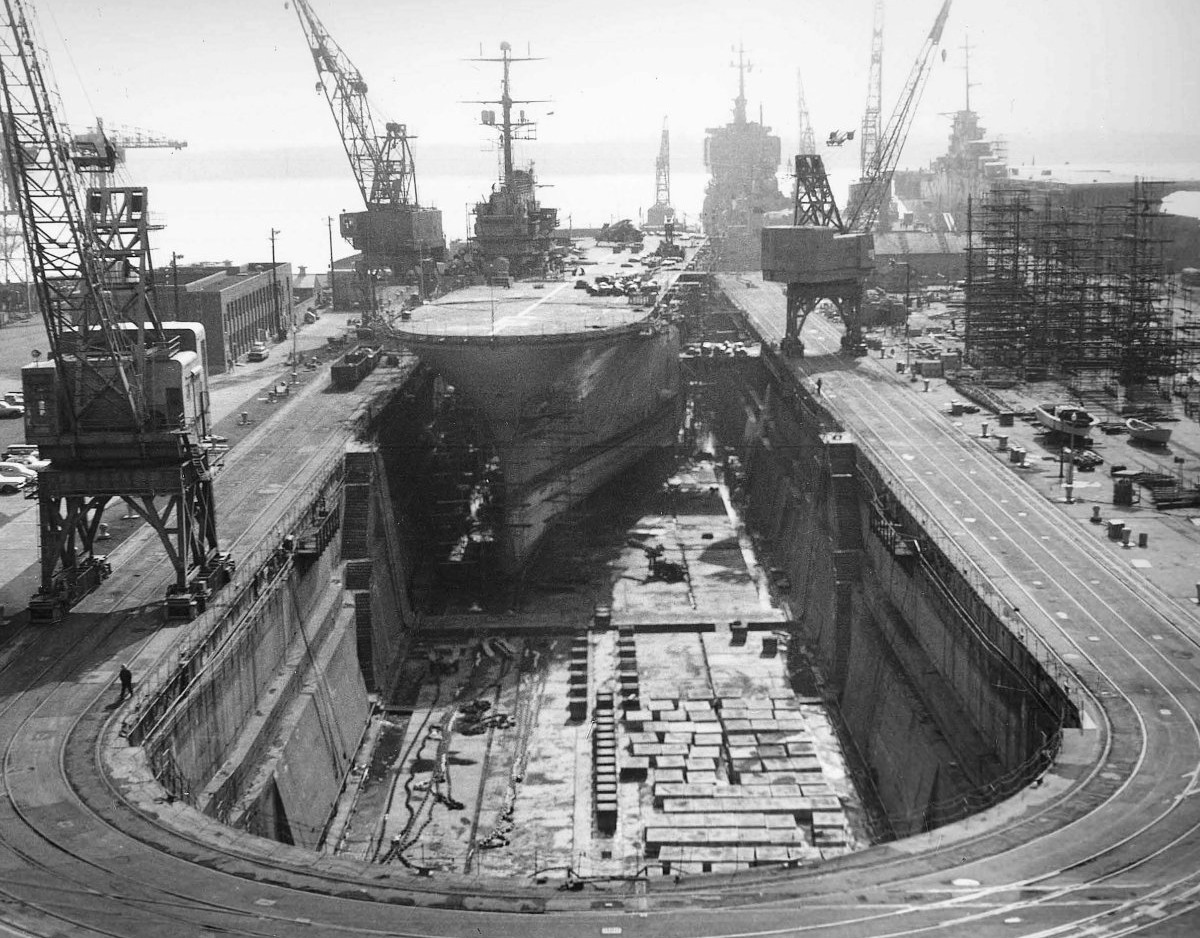 in dry dock at Philadelphia Naval Shipyard, Pennsylvania - 1963 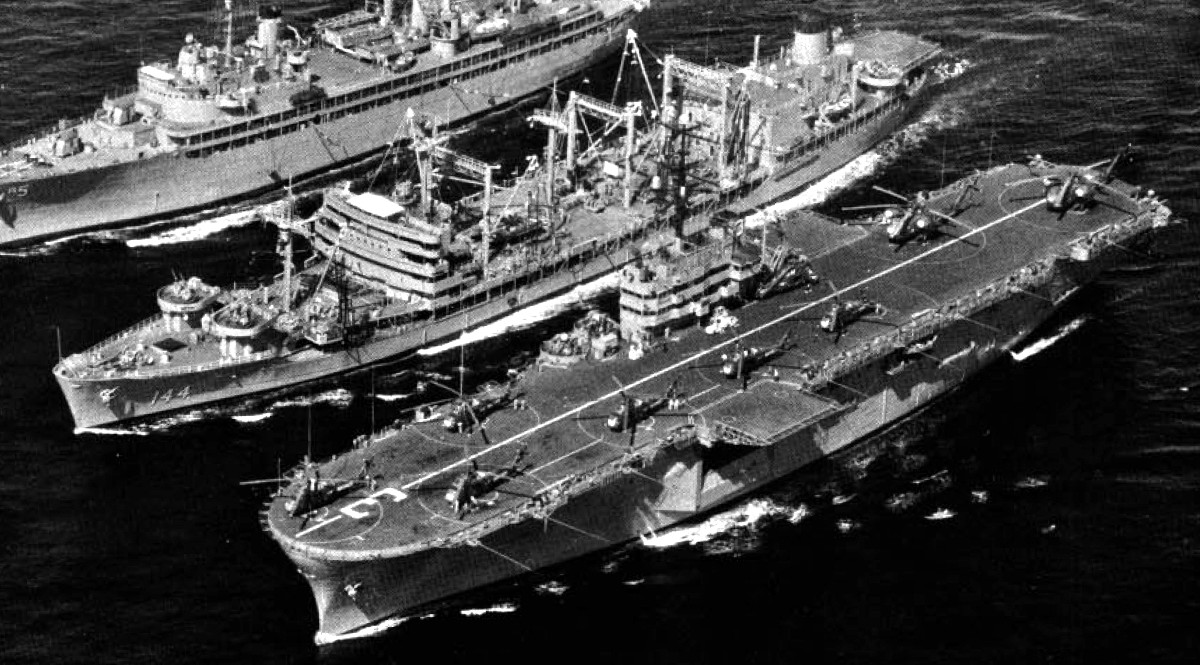 1962 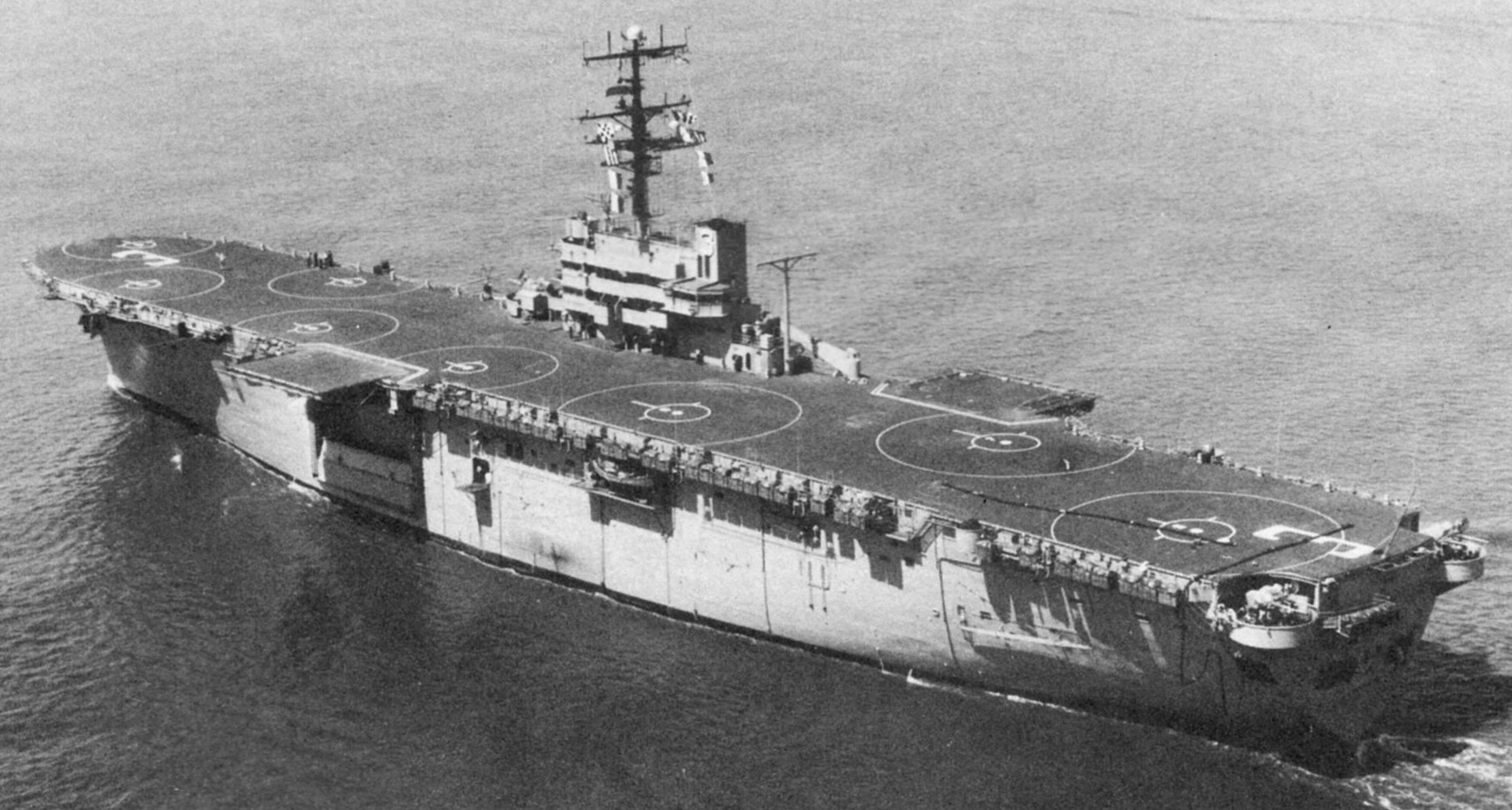 1962  1962 |
||
|
USS Okinawa (LPH 3): Okinawa (LPH-3) was laid down 1 April 1960 (15th anniversary of the invasion of Okinawa) by the Philadelphia Naval Shipyard, Philadelphia, Pa.; launched 19 August 1961; sponsored by Mrs. John L. McClellan, wife of the Senator from Arkansas; and commissioned 14 April 1962, Capt. William E. Lemos in command. Following commissioning and sea trials, Okinawa departed Philadelphia 20 June 1962 for her homeport, Norfolk, where she spent a month fitting out. After a six-week shakedown cruise out of Guantanamo Bay and another month in Norfolk, the amphibious assault ship began participation in her first fleet exercise in the Caribbean, 15 October. Shortly thereafter the Cuban Quarantine was placed in effect and Okinawa remained in the area, lending force to the United States' stand, until 3 December when she returned to Norfolk. The first half of 1963 was spent in availability at the Philadelphia and Norfolk Naval Shipyards and further trial operations in the Caribbean and out of Norfolk. On 9 July Okinawa began her first formal Caribbean deployment, returning to Norfolk 1 October and spending the remainder of that year and the first part of the next in that area. During June 1964 she sailed to Newport, R.I., and New York for the World's Fair. On 7 October she left on her first trip to European waters, for operation "Steel Pike I," an amphibious exercise off the coast of Spain. After a stop in France and a goodwill visit to Plymouth, England, Okinawa arrived back in Norfolk at the end of November. In April 1965, while participating in an exercise off Puerto Rico, Okinawa was alerted and sent to an area off the Dominican Republic to act as medical evacuation ship with her Marines as a floating reserve during the crisis in that troubled country. Then, following the end of her deployment, she proceeded via Norfolk to Philadelphia for overhaul. The following April she returned to Norfolk and began her third Caribbean deployment on 13 June. Okinawa transferred to the Pacific Fleet sailing 24 January 1967, for the West Coast, and arriving San Diego, her new home port, 8 February. Okinawa left on 10 March for her first deployment off Vietnam. On 13 April, while sailing from Okinawa to Taiwan, the ship was diverted by a distress call, and the next day rescued all 38 persons from the grounded Panamanian vessel Silver Peak near the Sento Shosho Islands. While off Vietnam, Okinawa was a mobile base from which a well-equipped force of Marines could quickly strike via helicopters at the Communist insurgents. She returned to San Diego 5 December. On 4 April 1968, after an intensive period of special training, Okinawa recovered the unmanned Apollo VI space capsule 380 miles north of Kauai, Hawaii. With further exercises and upkeep, she conducted her second Westpac deployment from 2 November to 26 June 1969, when she arrived in San Diego for leave and upkeep. Okinawa continues her role in support of freedom at home and abroad, alternating duty in home waters with deployments to the Far East into 1970. source: US NHHC - - - - - another history: Early career: Following commissioning and sea trials, Okinawa departed Philadelphia on 20 June 1962 for her homeport, Norfolk, Va., where she spent a month fitting out. After a six-week shakedown cruise out of Guantanamo Bay, Cuba and another month in Norfolk, the amphibious assault ship began participation in her first fleet exercise in the Caribbean, 15 October. Shortly thereafter the Cuban Missile Crisis arose and Okinawa remained in the area, lending force to the United States' stand, until 3 December, when she returned to Norfolk. The first half of 1963 was spent in availability at the Philadelphia and Norfolk Naval Shipyards and further trial operations in the Caribbean and out of Norfolk. On 9 July, Okinawa began her first formal Caribbean deployment, returning to Norfolk on 1 October and spending the remainder of that year and the first part of the next in that area. During June 1964, she sailed to Newport, Rhode Island and New York City for the World's Fair. On 7 October, she left on her first trip to European waters, for operation "Steel Pike I," an amphibious exercise off the coast of Spain. After a stop in France and a goodwill visit to Plymouth, England, Okinawa arrived back in Norfolk at the end of November. Dominican Republic: In April 1965, while participating in an exercise off Puerto Rico, Okinawa was alerted and sent to an area off the Dominican Republic to act as medical evacuation ship with HMM-263 (Reinf) and the 1st Bn., 2d Marines during the Dominican crisis. The mission concluded on 29 May. Then, following the end of her deployment, she proceeded via Norfolk to Philadelphia for overhaul. In April 1966 she returned to Norfolk and began her third Caribbean deployment on 13 June. Okinawa was transferred to the Pacific Fleet; she set sail for the West Coast on 24 January 1967 and arrived at San Diego, her new home port, on 8 February. Vietnam and Apollo spacecraft recovery: Okinawa left on 10 March for her first deployment off Vietnam. On 13 April, while sailing from Okinawa to Taiwan, the ship was diverted by a distress call, and the next day rescued all 38 persons from the grounded Panamanian vessel Silver Peak near the Sento Shosho Islands. While off Vietnam, Okinawa was a mobile base from which a well-equipped force of marines could quickly strike via helicopters at the Communist insurgents. She returned to San Diego on 5 December. On 4 April 1968, after an intensive period of special training, Okinawa recovered the unmanned Apollo 6 space capsule 380 miles north of Kauai, Hawaii. With further exercises and upkeep, she conducted her second Westpac deployment from 2 November to 26 June 1969, when she arrived in San Diego for leave and upkeep. On 17 May 1970, Okinawa delivered ten A-4K Skyhawk single-seaters, and four TA-4K two-seaters to New Zealand, after their purchase for the Royal New Zealand Air Force. The ship survived a severe storm after leaving Hawaii and the captain considered dumping the aircraft into the sea to save his ship but the storm abated. In 1970 Okinawa was awarded the Philippine Presidential Unit Citation for her humanitarian assistance to the people of Lagonoy Gulf, Republic of the Philippines, who had been devastated by Typhoon Jean in October 1970. On 7 August 1971, Okinawa was the recovery ship for the Apollo 15 spacecraft and crew of the fourth crewed Apollo program lunar landing mission. Fall of Vietnam: In April 1975, Okinawa participated in Operation Eagle Pull, the evacuation of Phnom Penh, Cambodia and Operation Frequent Wind, the evacuation of Saigon, Vietnam. From 7 October 1987 to 7 April 1988, Okinawa was deployed to the Persian Gulf in support of mine sweeping operations and MAGTF 1-88. She began her deployment heading West and continued West, circumnavigating the world. Gulf War: Okinawa was the command ship of the 13th Marine Expeditionary Unit in August 1990 as part of a WestPac deployment when it was diverted to the Persian Gulf in support of Operations Desert Shield and Desert Storm. Helicopters were launched as a diversion during the start of the ground phase of the war. Fate: Okinawa was decommissioned and stricken from the Naval Vessel Register on 17 December 1992. She was transferred to MARAD and laid up in the National Defense Reserve Fleet, in Suisun Bay, Benicia, California. The ship was sunk as a target in a COMSUBPAC ship sinking exercise (SINKEX) on 6 June 2002, off the coast of Southern California, in 2,020 fathoms (3,700 m) at 031°27′N 119°42′WCoordinates: 031°27′N 119°42′W. After being hit by several Maverick, Harpoon missiles, and general-purpose bombs, the ex-Okinawa was finally sunk by a Mk 48 torpedo fired by the USS Portsmouth. source: wikipedia |
||
|
The Battle of Okinawa ... (codenamed Operation Iceberg) was a major battle of the Pacific War fought on the island of Okinawa by United States Army and United States Marine Corps (USMC) forces against the Imperial Japanese Army. The initial invasion of Okinawa on 1 April 1945 was the largest amphibious assault in the Pacific Theater of World War II. The Kerama Islands surrounding Okinawa were preemptively captured on 26 March, (L-6) by the 77th Infantry Division. The 82-day battle lasted from 1 April until 22 June 1945. After a long campaign of island hopping, the Allies were planning to use Kadena Air Base on the large island of Okinawa as a base for Operation Downfall, the planned invasion of the Japanese home islands, 340 mi (550 km) away. The United States created the Tenth Army, a cross-branch force consisting of the U.S. Army 7th, 27th, 77th and 96th Infantry Divisions with the USMC 1st, 2nd, and 6th Marine Divisions, to fight on the island. The Tenth was unique in that it had its own Tactical Air Force (joint Army-Marine command), and was also supported by combined naval and amphibious forces. Opposing the Allied forces on the ground was the Japanese Thirty-Second Army. The battle has been referred to as the "typhoon of steel" in English, and tetsu no ame ("rain of steel") or tetsu no bōfū ("violent wind of steel") in Japanese. The nicknames refer to the ferocity of the fighting, the intensity of Japanese kamikaze attacks and the sheer numbers of Allied ships and armored vehicles that assaulted the island. The battle was one of the bloodiest in the Pacific, with approximately 160,000 military casualties combined: at least 50,000 Allied and 84,166-117,000 Japanese, including drafted Okinawans wearing Japanese uniforms. According to local authorities, at least 149,425 Okinawan people were killed, died by suicide or went missing, roughly half of the estimated pre-war population of about 300,000. In the naval operations surrounding the battle, both sides lost considerable numbers of ships and aircraft, including the Japanese battleship Yamato. After the battle, Okinawa provided a fleet anchorage, troop staging areas, and airfields in proximity to Japan in preparation for a planned invasion of the Japanese home islands. Okinawa Island ... is the largest of the Okinawa Islands and the Ryukyu (Nansei) Islands of Japan in the Kyushu region. It is the smallest and least populated of the five main islands of Japan. The island is approximately 106 kilometres (66 mi) long, an average 11 kilometres (7 mi) wide, and has an area of 1,206.98 square kilometers (466.02 sq mi). It is roughly 640 kilometres (400 mi) south of the main island of Kyushu and the rest of Japan. It is 500 km (300 mi) north of Taiwan. The total population of Okinawa Island is 1,384,762. The Greater Naha area has roughly 800,000 residents, while the city itself has about 320,000 people. Naha is the seat of Okinawa Prefecture on the southwestern part of Okinawa Island. Okinawa has a humid subtropical climate. Okinawa has been a critical strategic location for the United States Armed Forces since the Battle of Okinawa and the end of World War II. The island was under American administration until 1972, and today hosts around 26,000 US military personnel, about half of the total complement of the United States Forces Japan, spread among 32 bases and 48 training sites. |
||
| patches + more | ||
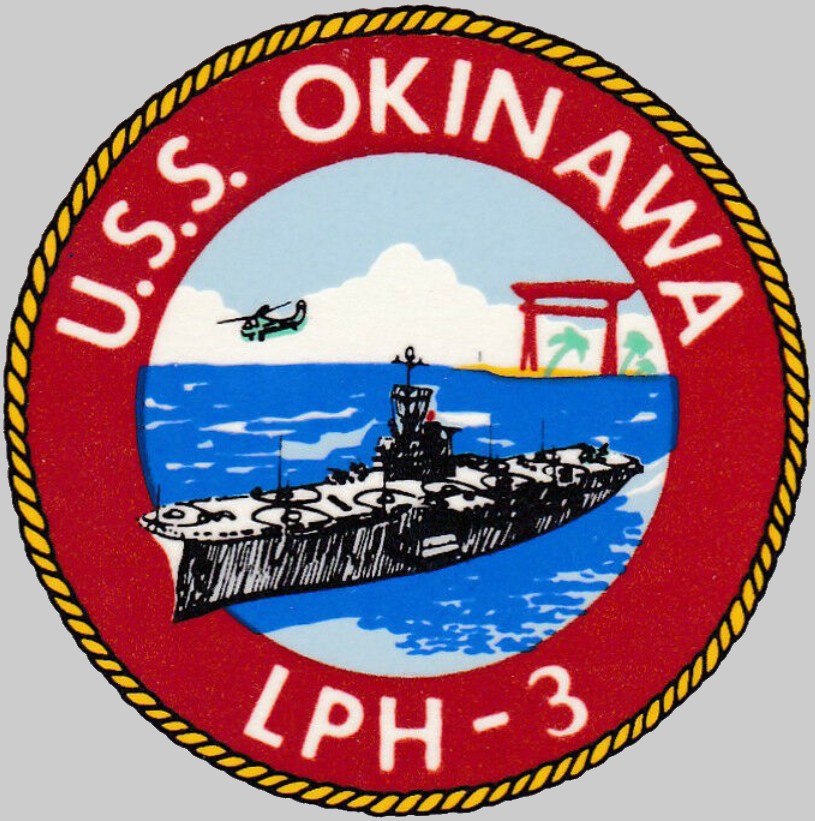 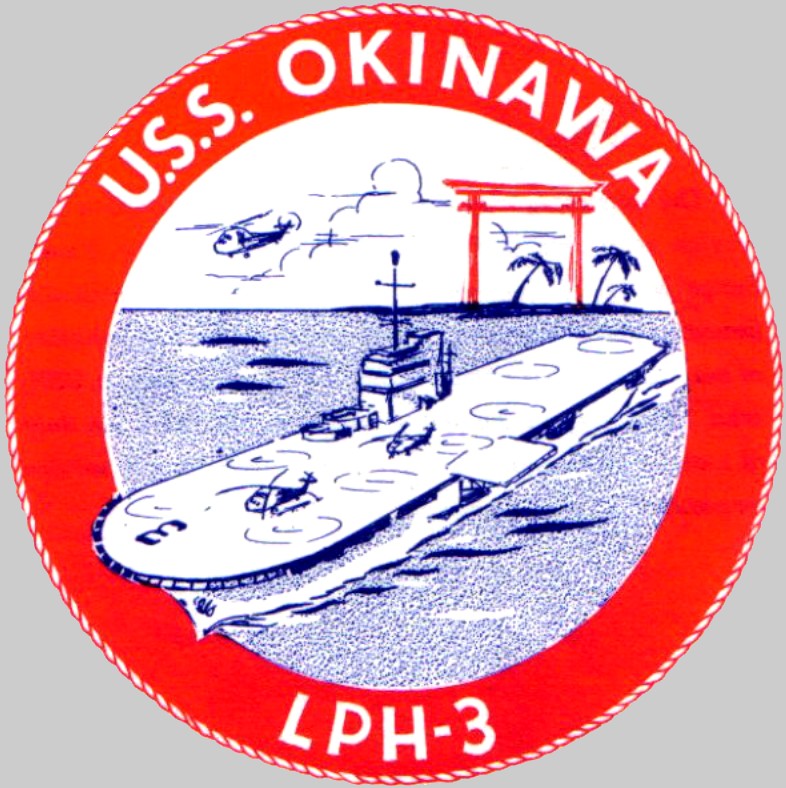 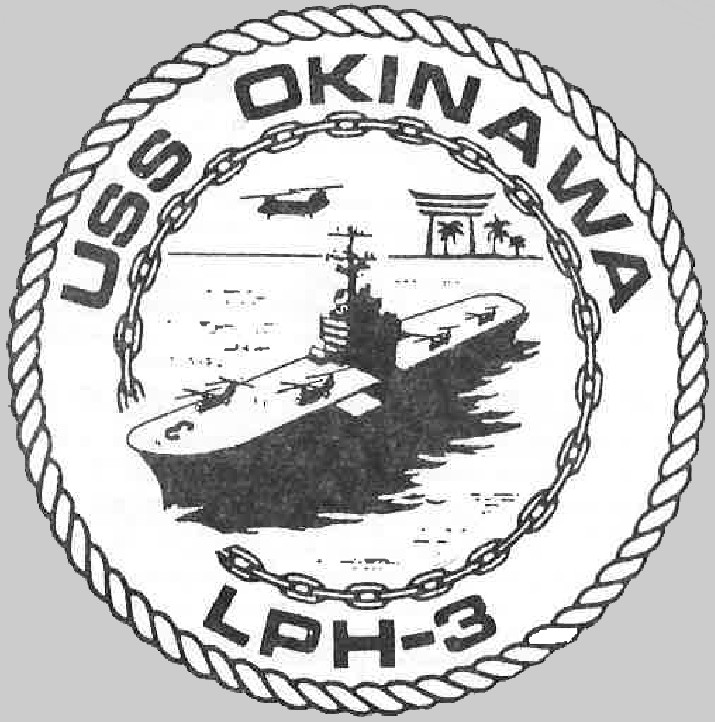 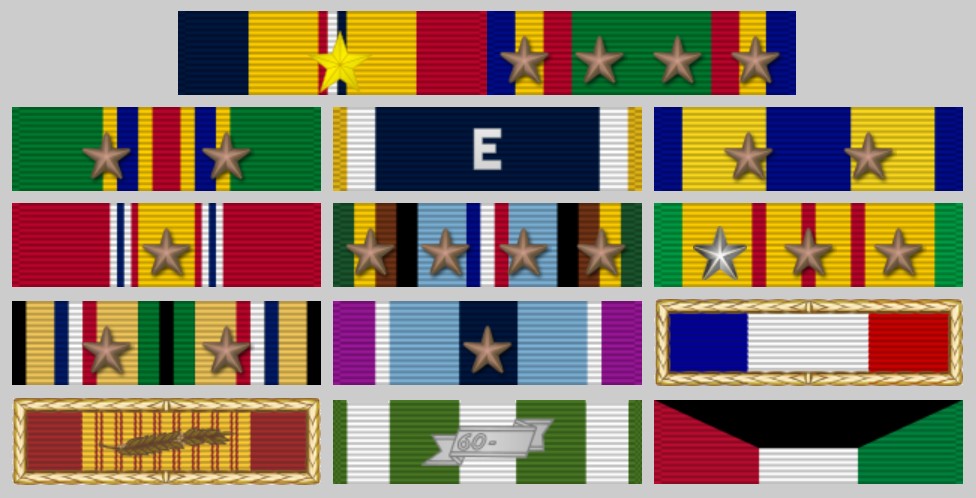 awards |
||
| | seaforces.org | USN ships start page | |